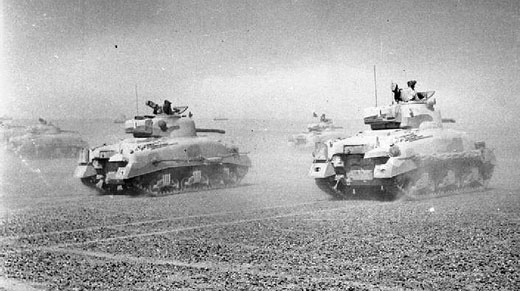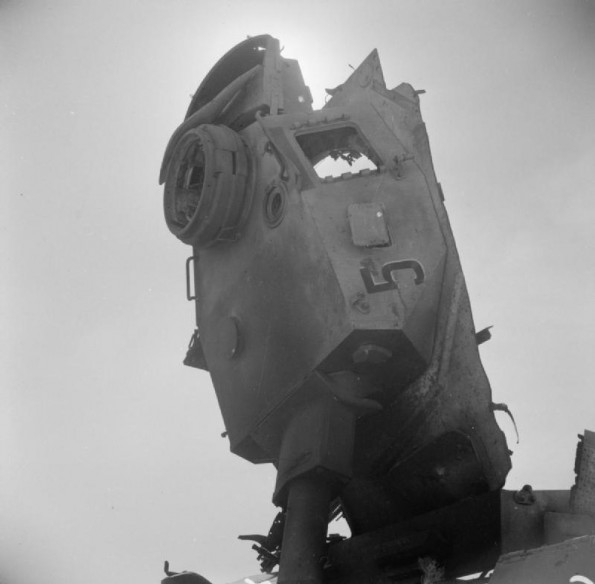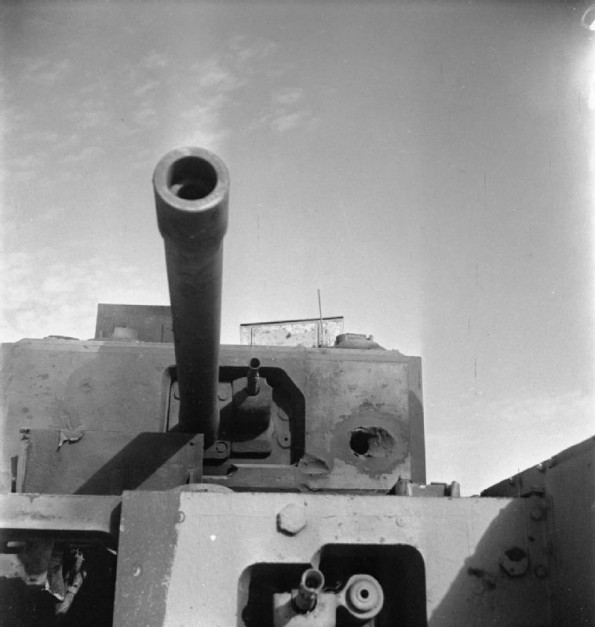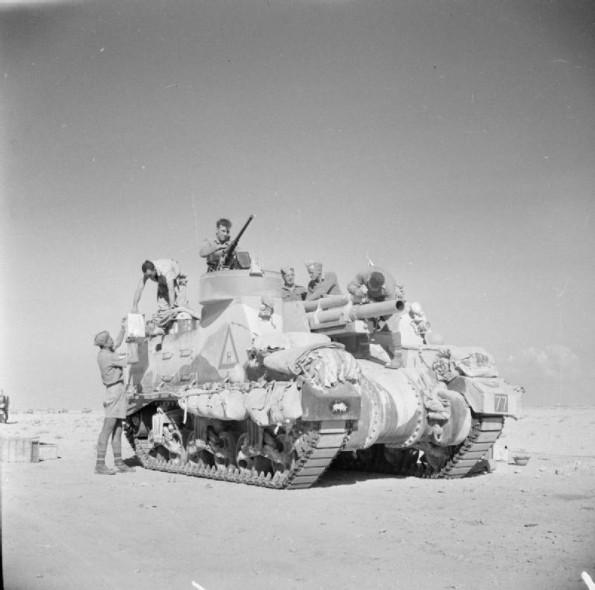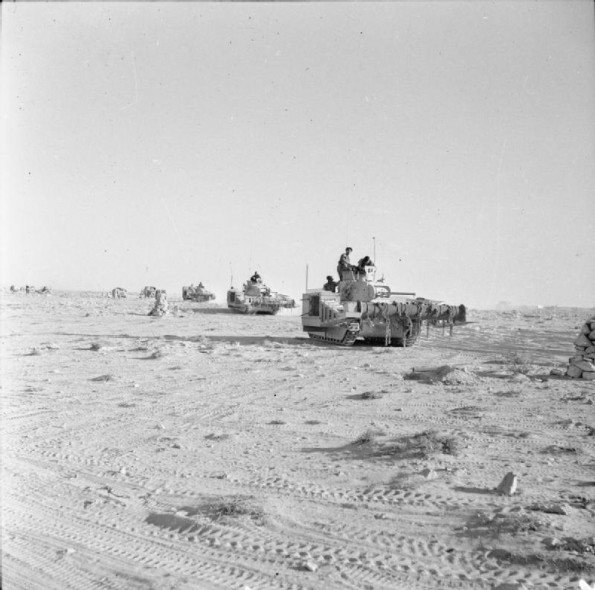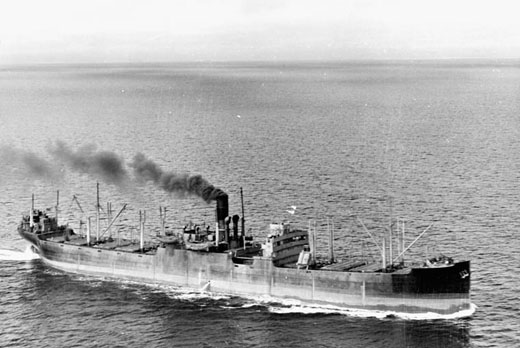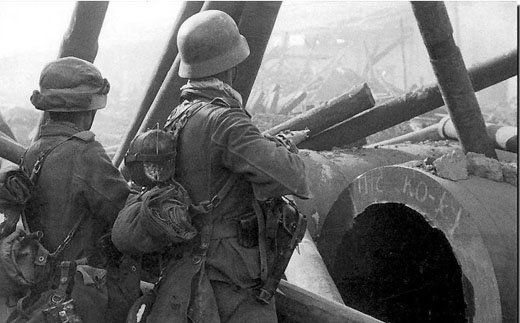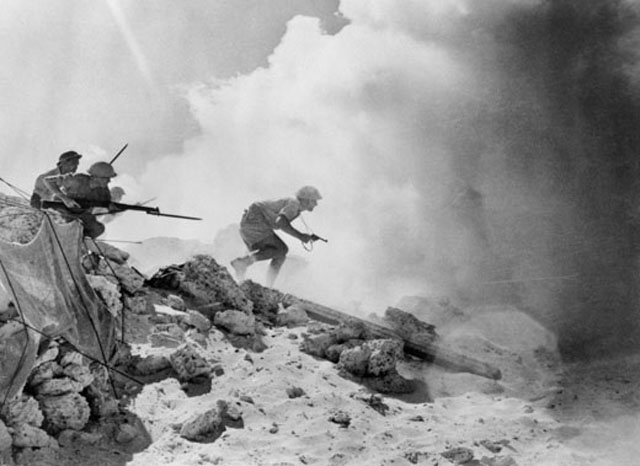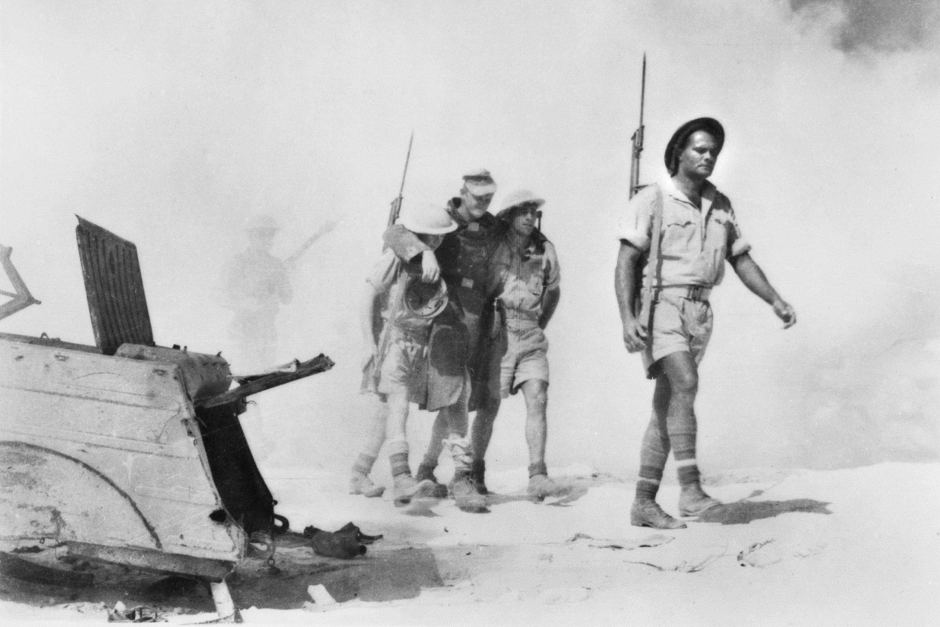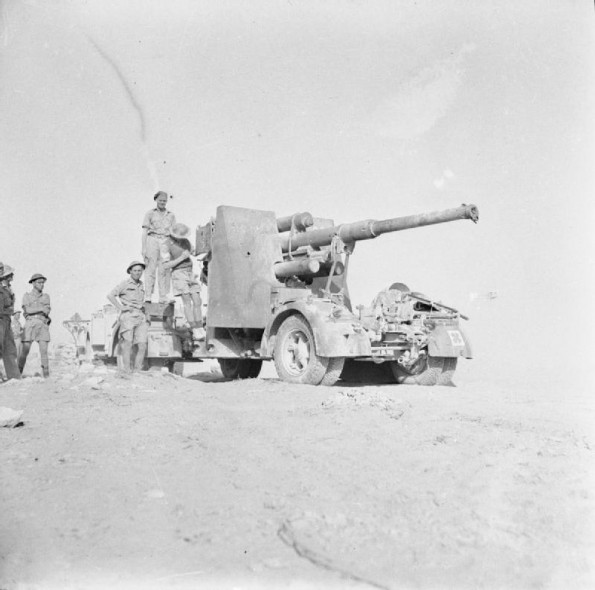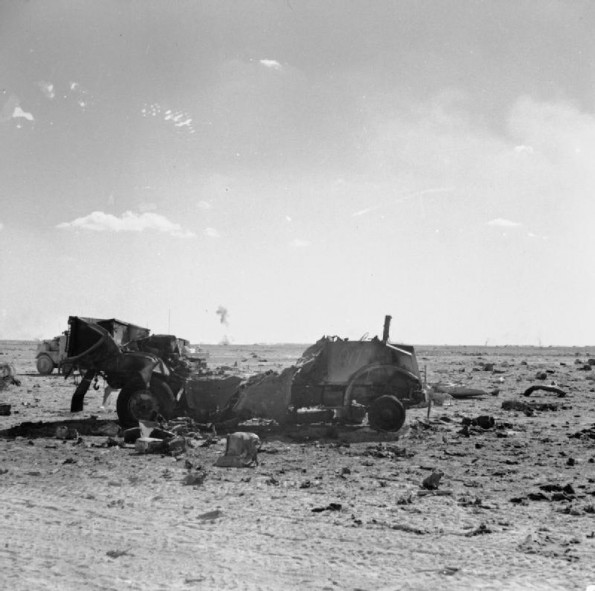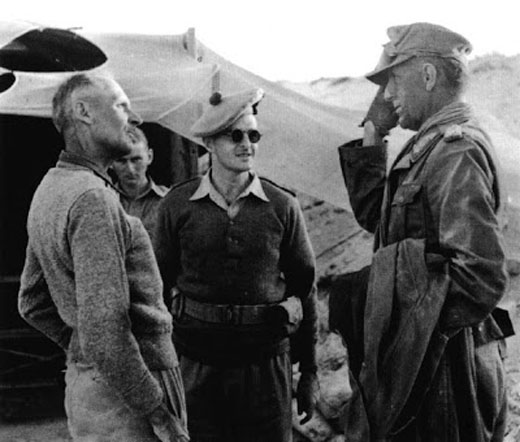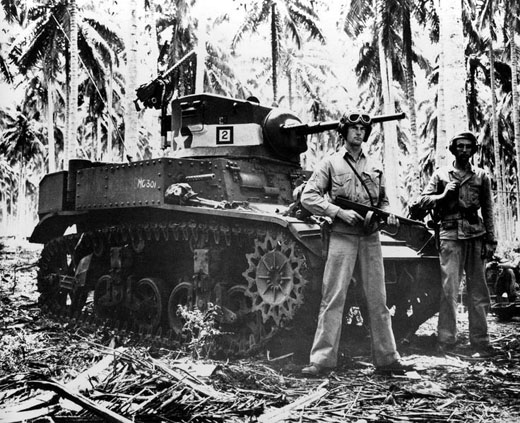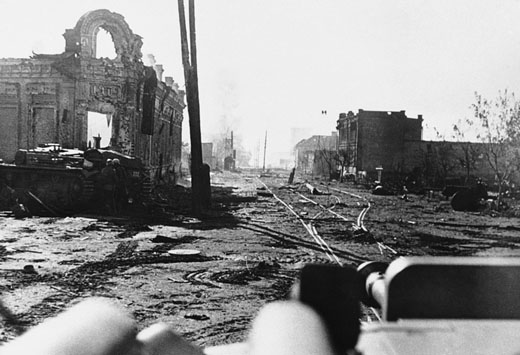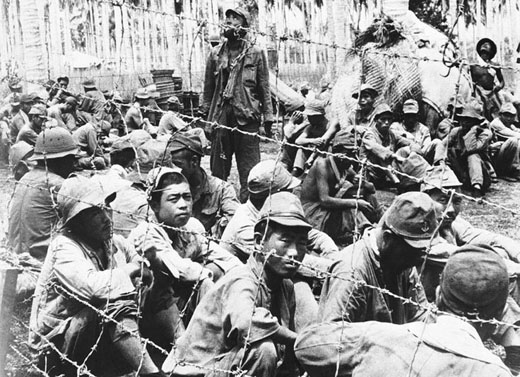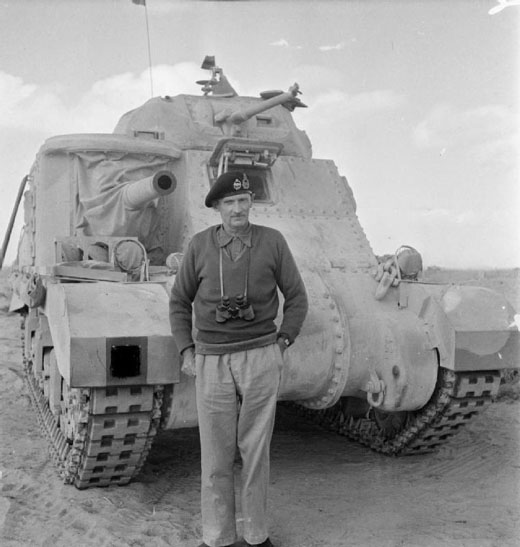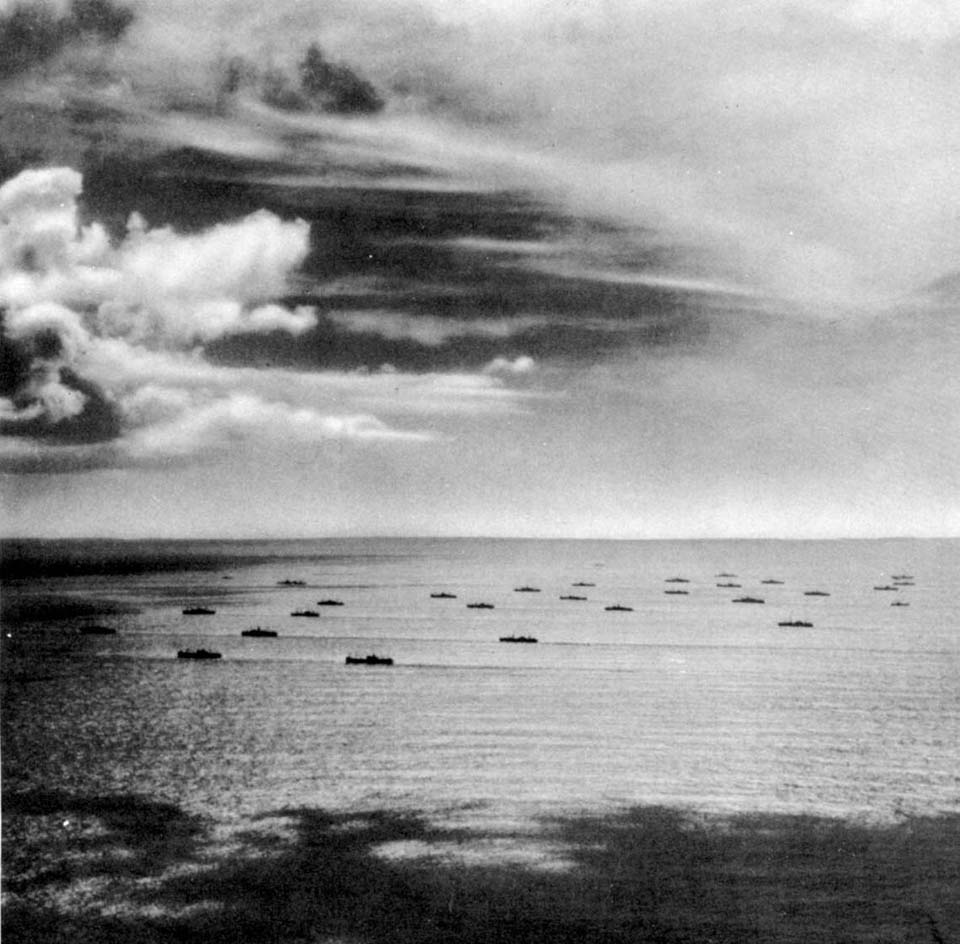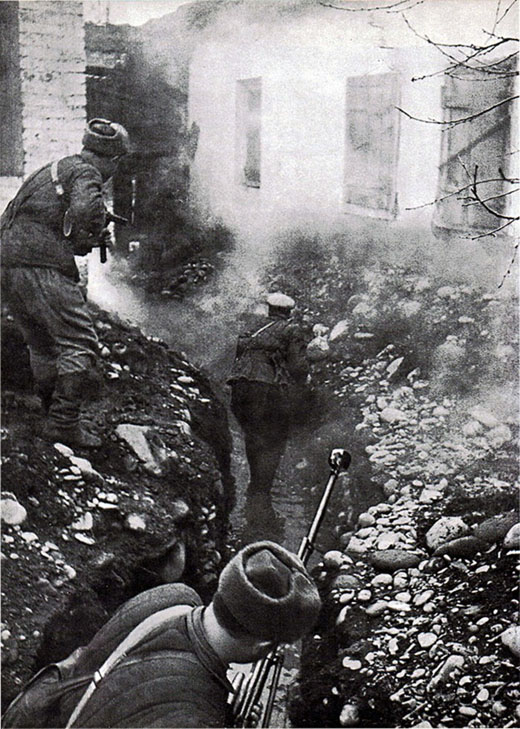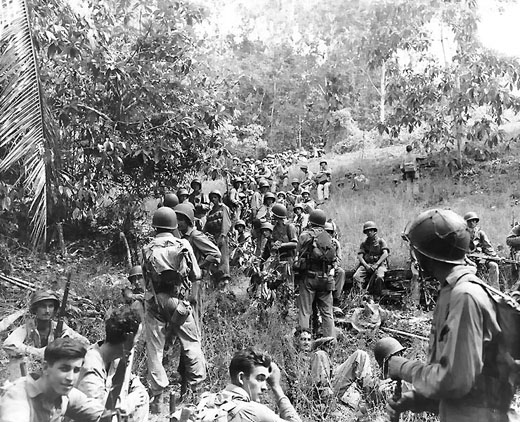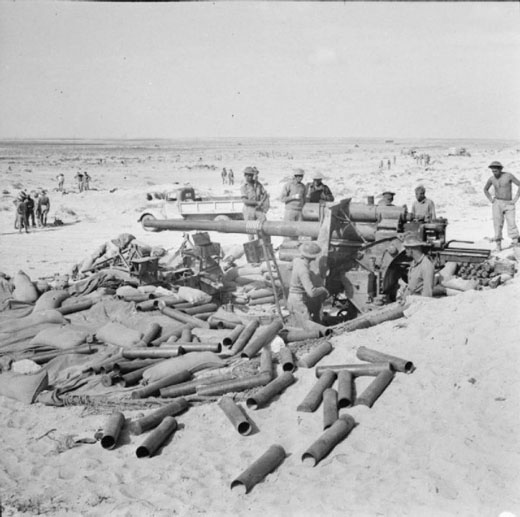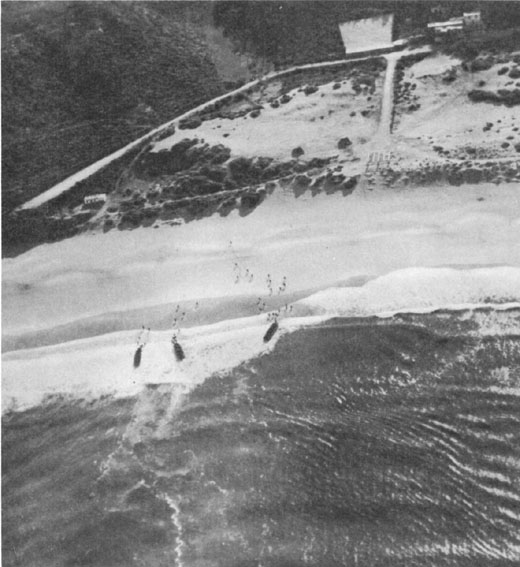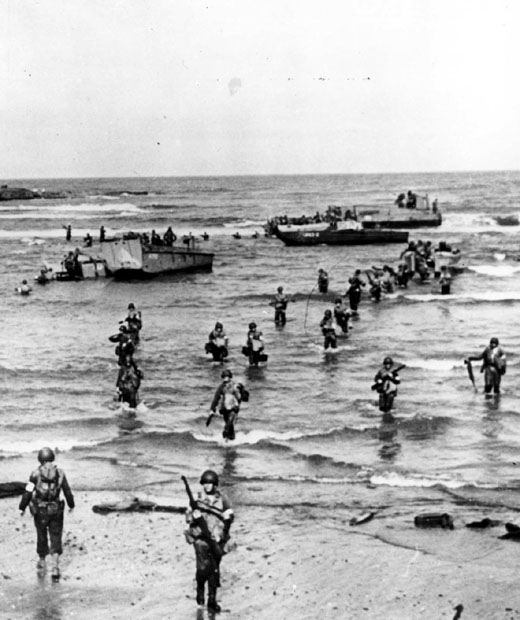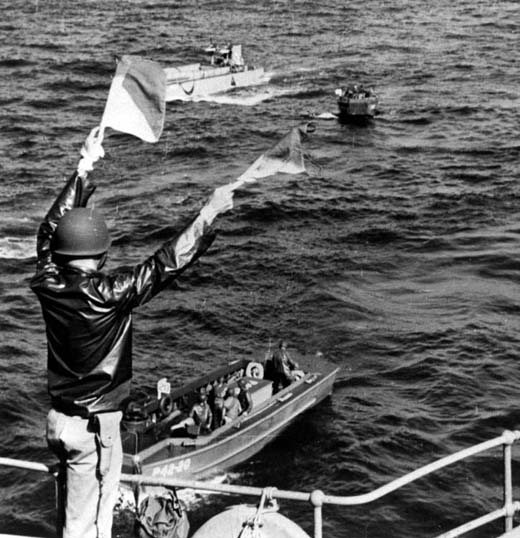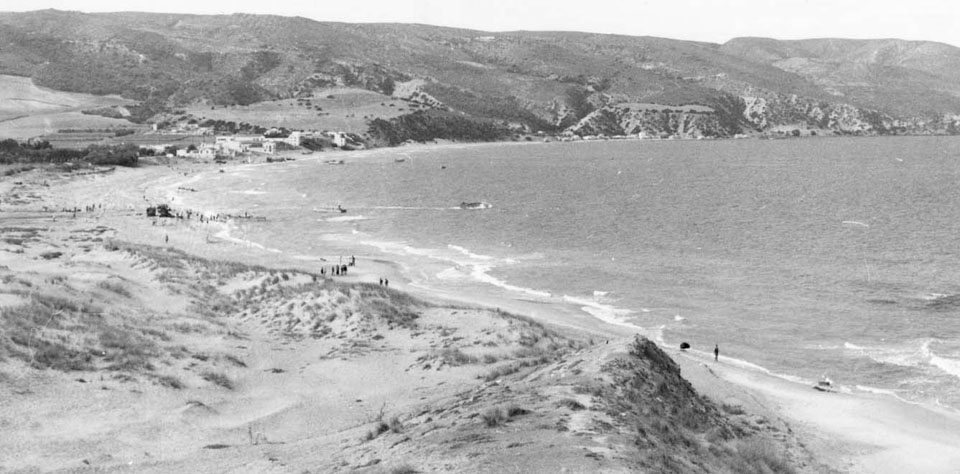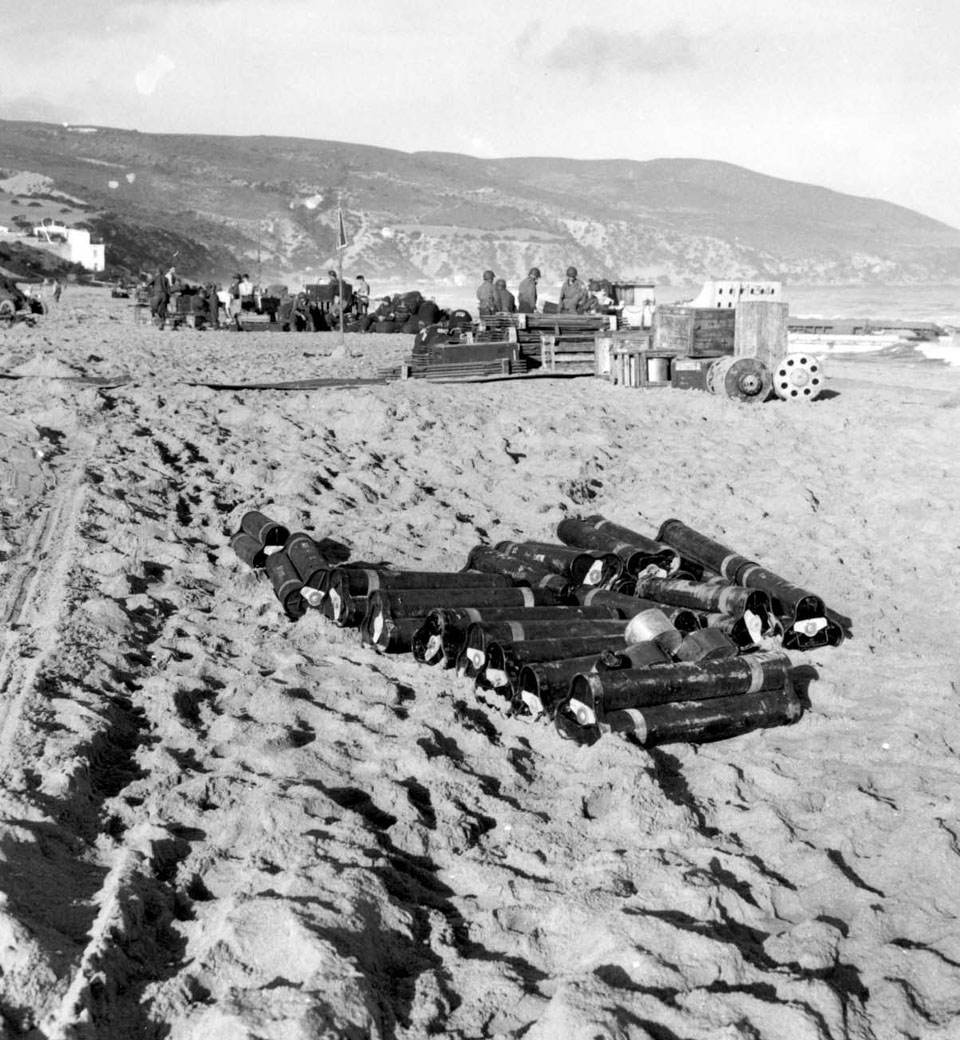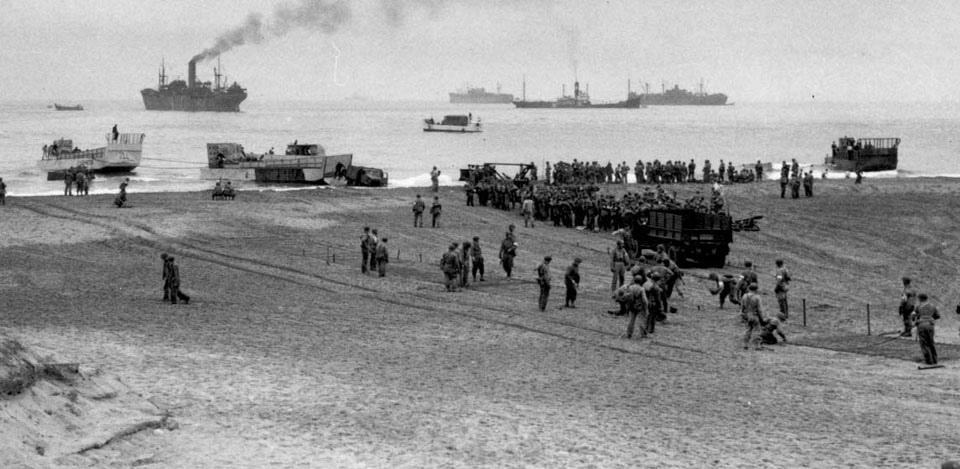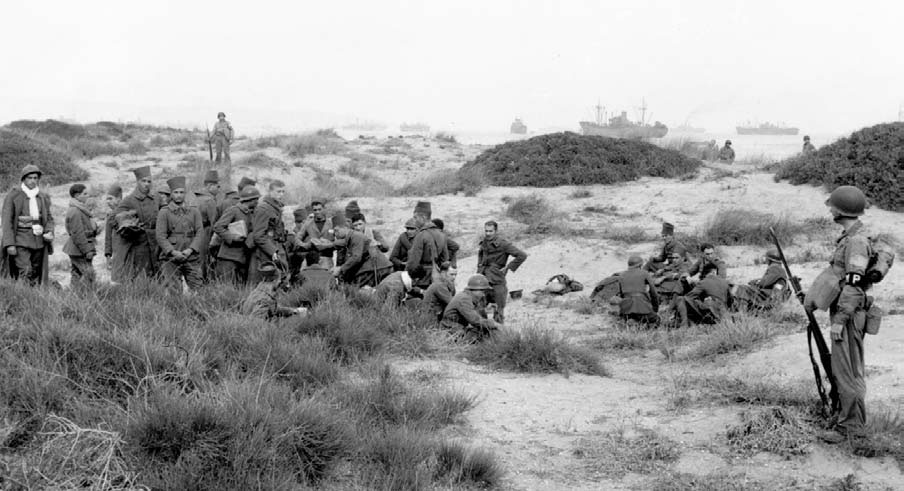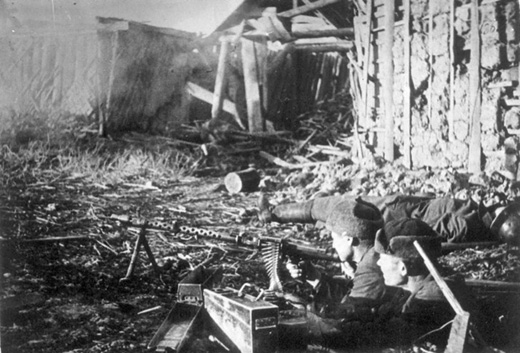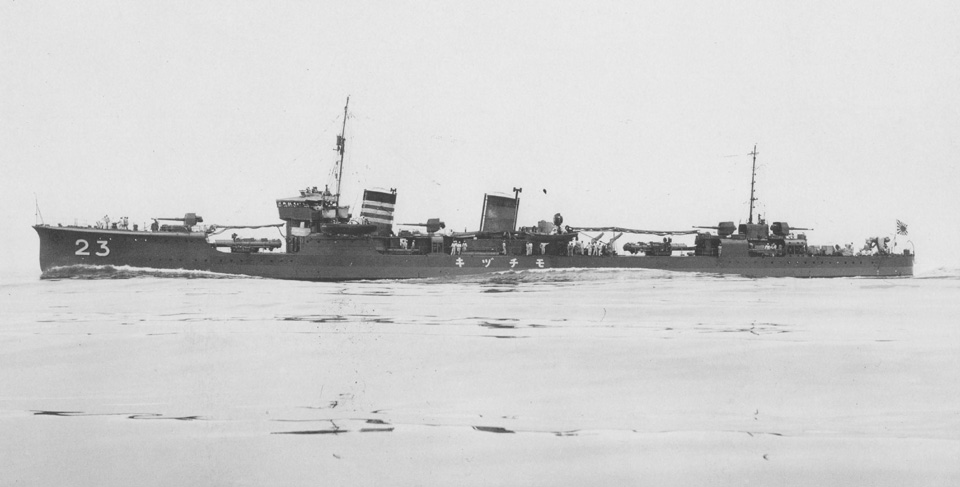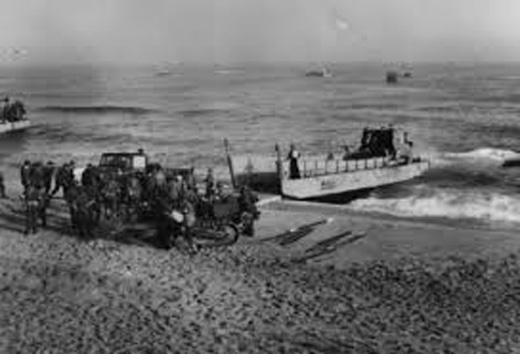Tuesday, November 10
Air Operations, Aleutians 5 28th Composite Bomb Group B-24s and 1 B-17 sent to attack the Kiska submarine base are unable to attack the primary because of bad weather, but they drop most of their bombs on targets of opportunity on the island.
[  | |   ] ]
Air Operations, Crete 376th Heavy Bomb Group B-17s attack the harbor at Candia.
[  | |   ] ]
Air Operations, Europe
BOMBER COMMAND
Daylight Ops:
- 18 Bostons are sent to continue the attack on the ship at Le Havre, but find it has been moved; 15 planes attack the dock area.
- 2 Bostons are lost crashing into the sea.
Evening Ops:
- 42 aircraft lay mines from the southern Biscay coast to the Frisians.
- No aircraft are lost in the operation until the return to England where 2 Lancasters crash.
[  | |   ] ]
Air Operations, Libya USAMEAF B-24s attack the harbor at Benghazi.
[  | |   ] ]
Air Operations, New Guinea - 22d Medium Bomb Group B-26s attack anti-aircraft emplacements at Sanananda and supply dumps between Sanananda and Soputa.
- 3d Light Bomb Group A-20s attack defensive positions at Soputa.
- 374th Troop Carrier Group transports airlift US Army infantry troops to Abels Field.
[  | |   ] ]
Air Operations, Solomons - Only 2 of 31 Cactus Air Force F4Fs in the air are able to get into position to intercept 15 A6M Zeros attempting a fighter sweep over Guadalcanal. 1 Zero is shot down by a VMF-112 F4F at 1110.
- 12 Cactus Air Force SBDs are dispatched against 5 Japanese troop-carrying destroyers located near Guadalcanal late in the day, but no hits are scored.
[  | |   ] ]
|
Axis Diplomacy Hitler, Laval and Ciano meet at Munich to discuss the situation in Africa and, as Hitler wishes, they decide to hold on to as much as possible.
[  | |   ] ]
Britain, Home Front Churchill, speaking at London's Mansion House, describes recent events in Africa as marking 'the end of the beginning' of the Allied efforts.
[  | |   ] ]
Eastern Front In response to intelligence reports of a Soviet buildup, some German units from XLVIII Panzer Corps are sent from around Stalingrad to bolster the reserves supporting 3rd Rumanian Army to the north.
[  | |   ] ]
Guadalcanal The 7th Marines and the 2nd Battalion of the 164th Infantry continue the reduction of the enemy pocket astride Gavaga Creek. An unsuccessful attempt is made to close the gap in the line. The westward offensive toward Kokumbona is renewed under the command of the CO of the 2nd Marines. The 1st Battalion of hte 164th Infantry and the 2nd Marines, less the 3rd Battalion, attack west from Point Cruz with the 8th Marines protecting the left rear.
Carlson's patrol reaches the lines of 2nd Battalion, 7th Marines, and verifies the report of a boxed in Japanese unit. 2 more companies reach Carlson doubling his strength. The Cactus Air Force shoots down 1 Zero during day. In the evening search planes find 5 destroyers 210 miles north of Guadalcanal coming to land more troops during darkness. 17 fighters and 8 dive bombers attack destroyers but make no hits. The Minesweeper Southard attacks and sinks the Japanese submarine I-172 off San Cristobal Island.
[  | |   ] ]
Mediterranean - U-431 sinks the British destroyer Martin northeast of Algiers with the loss of 161 of her crew. There are 63 survivors.
- The British sloop Ibis is sunk by German bombing in the Western Mediterranean with the loss of 107 of her crew.
[  | |   ] ]
New Guinea The Australian 16th Brigade forces the Japanese back form Oivi towards the mouth of the Kumusi River. After a fierce battle lasting 2 days the Australian 25th Brigade takes Gorari. The Japanese force at Oivi is, therefore, cut off and with it Gen Horii.
[  | |   ] ]
|
North Africa
ALGERIA
François Darlan reads over the radio a proclamation in which he orders French forces in Algeria and Morocco to cease all resistance to the Allies. A similar appeal to sail and join the Allies is sent to the powerful French Fleet at Toulon. Units of the 1st Infantry Division and Combat Command B, 1st Armored Division, converge on Oran. Elements of the 16th Regimental Combat Team are in the city at 0830. The armored columns enter Oran from the south before the French commanding general surrenders at 12:30pm.
MOROCCO
French resistance in the Port-Lyautey area ceases. The airport is repaired at once and by noon 12th Air Force fighter squadrons from the aircraft carrier Chenango land there. US forces from Fedala close in on Casablanca and prepare for a concerted assault at dawn on the 11th. Combat Command B, 2nd Armored Division, breaks off its drive toward Marrakech from the Safi area and marches toward Mazagan in order to conserve strength for the attack on Casablanca. US naval forces engage French ships at Casablanca.
LIBYA
Troops of the British 8th Army take Halfaya Pass.
[  | |   ] ]
Pacific The US high speed minesweeper Southard (DMS-10) sinks the Japanese submarine I-15 5 miles off Hada Bay, the northwest point os San Cristobal Island, Solomons.
[  | |   ] ]
Secret War The Swiss Joint Federal Assembly rejects the appeals against death sentences imposed on 3 Swiss soldiers, Zürcher, Feer and Schmrämli, convicted of passing details of Switzerland's alpine defenses to foreign Powers.
[  | |   ] ]
Vichy France Marshal Pétain announces that he has taken command of French sea, land and air forces.
[  | |   ] ]
|
Images from November 10, 1942
|
|
US Battleship New York (BB-34) off North Africa
|
 |
|
Pursuing the Enemy along a Flooded Road
|
 |
|
|
Wednesday, November 11
Air Operations, CBI 9 10th Air Force P-40s attack Shingbwiyang, Burma.
[  | |   ] ]
Air Operations, Egypt 57th Fight Group P-40s down 8 Axis aircraft in two separate engagements.
[ | |   ] ]
Air Operations, Europe
BOMBER COMMAND
Evening Ops:
- 31 Wellingtons lay mines to the Biscay ports and the Frisians without a loss.
[  | |   ] ]
Air Operations, Mediterranean USAMEAF B-24s attacking Axis shipping at sea north of the Libyan coast claim 4 direct hits on one vessel.
[  | |   ] ]
Air Operations, New Guinea - 3rd Light Bomb Group A-20s attack the Wairopi area.
- The 374th Troop Carrier Group airlifts a US Army regimental headquarters from Port Moresby to the new Pogani Advance Airstrip.
[  | |   ] ]
Air Operations, Solomons - At 0930 hours, 9 D3A 'Val' dive-bomber 18 A6M Zeros from the Japanese carrier Hiyo attack US troop transports, cargo ships, and surface escorts off Guadalcanal. One transport is slightly damaged by a near miss. Marine Corps F4Fs down 5 'Vals' and 5 Zeros, but 6 VMF-121 F4Fs and 4 of the pilots are lost. 1 other Zero is shot down by a 347th Fighter Group P-39.
- At 1100 hours, 25 G4M 'Betty' bombers and 26 A6M Zeros attempting to attack Henderson Field are intercepted by 17 Marine Corps F4Fs. 7 'Bettys' and 1 Zero are shot down. 1 F4F is lost, but its pilot is rescued. Also, a 347th Fighter Group P-39 downs a 'Betty'.
- V Bomber Command B-17s attack shipping off southern Bougainville.
[  | |   ] ]
Atlantic The British submarine Unbeaten is sunk in error by British aircraft in the Bay of Biscay. All 36 of her crew are lost.
[  | |   ] ]
Axis Diplomacy Germany announces that she will respect Spanish neutrality despite developments in southern France, but Hitler has previously ordered contingency planning for the occupation of Spain.
[  | |   ] ]
Battle of the Atlantic - All available U-boats, 25, are withdrawn for the north Atlantic an formed into 2 groups: Schagetot, 'Bully', and Westwall off Morocco and Gibraltar for operations against Allied Task Forces in Operation TORCH. 10 transports are sunk, 1 transport and 1 tanker damaged, 1 carrier and depot ship sunk. The Germans lose 1 U-boat with 8 others being damaged.
- The German submarine U-173 torpedoes and sinks the US transport Joseph Hewes (AP-50) (9359t) and torpedoes the destroyer Hambleton (DD-455) and oiler Winooski (AO-38) off Fedala Roads, North Africa.
[  | |   ] ]
|
Eastern Front In Stalingrad von Paulus' last major attack begins. The Germans make another attempt to eliminate the Russian bridgehead on the river bank in the city center. Squads of assault engineers crawl through sewers and tunnels while tanks attempt to traverse shattered rubble-clogged streets. There is, as usual, vicious fighting with heavy casualties on both sides. Despite some new German tactics the Soviets are able to fragment the German effort so that within two days all central control is lost and the offensive degenerates into a series of unconnected actions. Some German groups are able to penetrate to the Volga while others are cut off from support. The German command is unable to follow the course of the battle and thus the Soviet small-unit expertise gradually prevails. The offensive continues for six days. The Soviets are having problems because floating blocks of ice on the Volga are making the river crossing almost impossible.
SOUTHERN USSR
The German 6th Army commences its final offensive at Stalingrad, preceded by artillery and air strikes. It succeeds in taking most of the Red October factory and isolating the Soviet 138th Division south of the Barrikady factory. By the evening, the 62nd Army occupies three small pockets along the Volga: in the north 1,000 troops at Rynok and Spartakovka; in the center 500 troops near the Barrikady factory; and in the south 45,000 troops and 20 tanks.[MORE]
[  | |   ] ]
France In Operation ANTON Hitler orders German troops to move into Vichy. German troops enter Unoccupied France, taking possession of Vichy, Limoges, Lyons and several other places. Pétain broadcasts on the radio his official protest against the German invasion of Vichy France: 'I have tonight received a letter from the Führer telling me that, on necessary military grounds, he is forced to take certain steps which will result in the suppression of the agreements and the actual fundamental terms of the armistice. I protest formally against these decisions, which are incompatible with the terms of the armistice.'
The Italians seize Corsica.
[  | |   ] ]
French North Africa The French authorities sign an armistice with the Allies and all resistance by Vichy troops ceases at 7:00am. Half an hour later the American 3rd Infantry Division, which would have had to take Casablanca by assault, enters the city amid popular enthusiam. The various military installations are taken over by Allied troops. The British 11th Brigade begins to move east from Algiers in strength and the 36th Brigade of the British 1st Army lands at Bougie which is taken without meeting any resistance. The 11th Brigade of the 78th Division moves from Algiers towards Bône. These forward forces have little air cover and several of the ships at Bougie carrying important equipment are sunk by the Luftwaffe during the next few days. The Germans now have over 1,000 troops in Tunisia.
[ ] ]
Guadalcanal At 0530 the 3 transports (Zeilin, Libra, Betelgeuse) begin unloading but are interrupted twice during the day by enemy bombers which damage all 3 ships. The transports retire at 1800 to Indispensable Strait. The damage to the Zeilin is serious and it is escorted by destroyer back to Espiritu Santo. A naval force bringing reinforcements and supplies from New Hebrides arrives and begins unloading. When 3 transports of the force are damaged by enemy aircraft, the group retires to join naval forces approaching New Caledonia.
Japanese carriers send 10 dive bombers and 12 Zeros to attack Henderson Field. F4Fs go up to intercept. They claim 5 Zeros and 1 bomber with 2 Zeros and 1 bomber as 'probables'.
|
The westward offensive toward Kolumbona is halted bacause of strong indications that the enemy may attempt to recover the Lunga area. After reaching positions a little beyond those gained on November 4, the assault force begins to withdraw across the Matanikau. East of the Lunga perimeter, the 2nd Battalion, 164th Infantry, closes a gap on the southern flank of the US line about the enemy along Gavaga Creek and drives north toward the beach while the 7th Marines closes in from the east and west. The Japanese are determined to prevent the Americans from taking Kokumbona, the site of the 17th Army command post and one end of the main supply trail to positions the Japanese were preparing on Mount Austen. The defense of the village is assigned to Maj-Gen Takeo Ito, Infantry Group Commander, 38th Division. He had landed November 5th and took command of a reserve force of 5,000 men. In an effort to outflank the Americans, he takes his force into the jungled hills on left flank of Americans 5,000 yards south of the beach. Before he could launch, the Americans, unaware he was there, receive word the Japanese are preparing to bring large troop convoys to Guadalcanal in mid-November. To meet the threat of another counteroffensive, all troops are needed within Lunga perimeter. The American battalions disengage. The 2nd and 8th Marines pull back toward the Matanikau covered by the 1st Battalion, 164th Infantry.
[  | |   ] ]
Indian Ocean Two Japanese merchant raiders attack the Indian minesweeper Bengal and the armed tanker Ondina in the Indian Ocean southwest of Cocos Island. In the ensuing action Bengal sinks the Hokoku Maru (10,438t) and drives the Aikoku Maru off despite an enormous disparity of force. Both Japanese ships have 6 6-inch guns, while the Bengalhas 1 3-inch and the Ondina 1 4-inch. The Bengal escorts the Ordina to Fremantle. This action ranks with that of the Stephen Hopkins as one of the most remarkable defenses made by small ships during the war.
[  | |   ] ]
Mediterranean The troopship Viceroy of India is sunk by U-407 off the north African coast.
[  | |   ] ]
New Guinea The disease-ravaged and exhausted Japanese suffer another defeat on Papua, losing 600 men in an Australian flanking action at the town of Oivi. The advancing Australians are heavily engaged around Gorari during the next 3 days. When the Japanese finally manage to pull back across the Kumusi River they leave behind 60 dead. Gen Horii is drowned during the retreat. This battle signals the collapse of organized Japanese resistance outside their beachhead at Gona and Buna.
[  | |   ] ]
North Africa
ALGERIA
The British 1st Army lands elements of the 37th Brigade, 78th Division, at Bougie, 110 miles east of Algiers, without opposition. Hart Force, a mobile task force based on the 11th Brigade, 78th Division, moves out of Algiers toward Bône, traveling overland.
MOROCCO
The Western Task Force cancels its attack on Casablanca because of the armistice. The 3rd Division enters the city at 0730. Combat Command B, 2nd Armored Division, receives the surrender of Mazagan and establishes a bridgehead at Azemmour without opposition. Enemy torpedoes sink a US transport off the coast.
LIBYA
The X Corps of the British 8th Army, still following up the retreating Axis forces, enters Libya and occupies Bardia without a shot fired. The 1st and 7th Armored Divisions are on the heels of the Axis rearguards in Libya. The 2nd New Zealand Division halts on the Libyan-Egyptian border to reorganize.
[  | |   ] ]
Pacific The US submarine Haddock (SS-231) sinks the Japanese merchant carog ship Venice Maru (6571t) in the center of the Yellow Sea, between China and Korea.
[  | |   ] ]
|
Images from November 11, 1942
Greek Jews to Register for Forced Labor
|
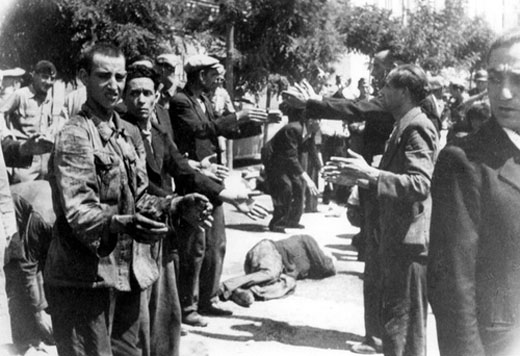 |
|
General Nogues Arriving at Fedala
|
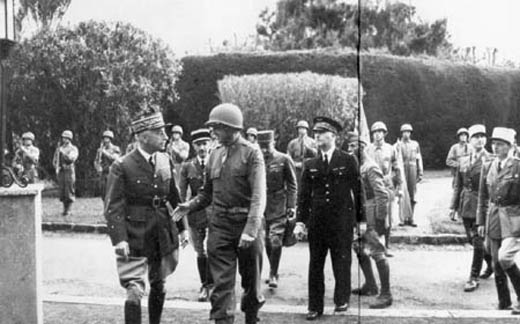 |
|
Sherman on a Tank Transporter
|
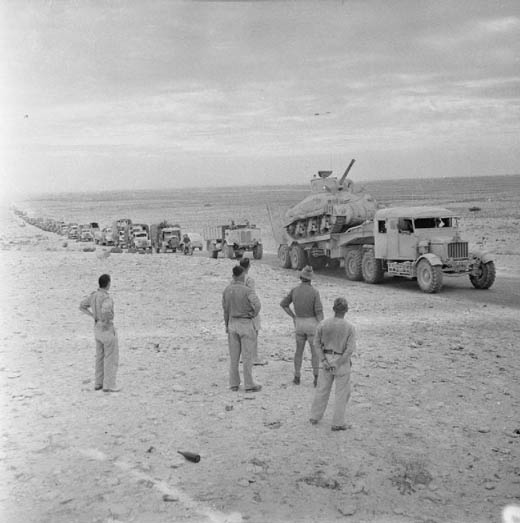 |
|
Thursday, November 12
Air Operations, CBI 23rd Fighter Group P-40s down 3 A6M Zeros over the airfield at Kweilin and Lingling during 2 separate morning engagements.
[  | |   ] ]
Air Operations, New Guinea 374th Troop Carrier Group airlifts a US Army infantry battalion to Pongani from Port Moresby.
[  | |   ] ]
Air Operations, North Africa The US 9th Army Air Force is formed.
[  | |   ] ]
Air Operations, Solomons - 19 G4M 'Bettys' mounting a low-level torpedo attack against a US reinforcement convoy at 1305 hours are thwarted by Marine Corps F4Fs, 347th Fighter Group P-39s, and anti-aircraft fire from the ships. 3 transports are damaged and 1 heavy cruiser is seriously damaged when intentionally struck by a damaged 'Betty', but 16 of the 'Bettys' and 7 A6M Zero escorts are downed. 3 F4Fs and 1 P-39 are lost.
- V Bomber Command B-17s attack shipping in Tonolei harbor.
[  | |   ] ]
Baltic Sea U-272 sinks after colliding with another U-boat, U-634, near Hel.
U-272|
| Class | Type VIIC |
| CO |
Kapitänleutnant Horst Hepp |
| Location |
Baltic, off Hela |
| Cause |
Collision |
| Casualties |
29 |
| Survivors |
19 |
[  | |   ] ]
\
Battle of the Atlantic U-515 sinks the British destroyer tender Hecla (10,850t) west of Gibraltar. 279 on board are lost. 568 survivors are picked up by the British destroyer Venomous.
[  | |   ] ]
Naval Battle of Guadalcanal During the night the Japanese naval squadron is reported by the radar stations between Savo Island and Cape Esperance. In Iron Bottom Sound between Savo and Guadalcanal a furious battle breaks out. The US forces include the aircraft carrier Enterprise, the battleships Washington and South Dakota, the cruisers San Francisco, Pensacola, Portland, Helena, Juneau, Atlanta, Northampton and San Diego, 22 destroyers and 7 transports, with 79 aircraft on board the Enterprise and 194 more based on Guadalcanal and New Hebrides. The Japanese force includes the carrier Junyo and Hiyo, with 95 aircraft, the battleships Hiei, Kirishima, Kongo and Haruna, the cruisers Atago, Takao, Sendai, Nagara, Tone, Chokai, Kinugasa, LSuzuya, Maya and Tenryu, 30 destroyers, 14 submarines and 11 transports. This fleet is supported by 215 aircraft from bases on New Britain. The battle is fought out both by the naval and air forces with the following outcome: the American lost the light cruisers Atlanta and Juneau and 7 destroyers, while the cruisers San Francisco, Portland and Helena, the battleship South Dakota and 4 destroyers are damaged. The Japanese have to record the sinking of the battleships Hiei and Kirishima, the heavy cruiser Kinugasa, 2 destroyers and 7 of the 11 transports that should have landed over 10,000 men as reinforcements on Guadalcanal. Only 4,000 men and a few tons of supplies are later able to be unloaded at Tassafaronga.[MORE]
|
'The Slot'
|
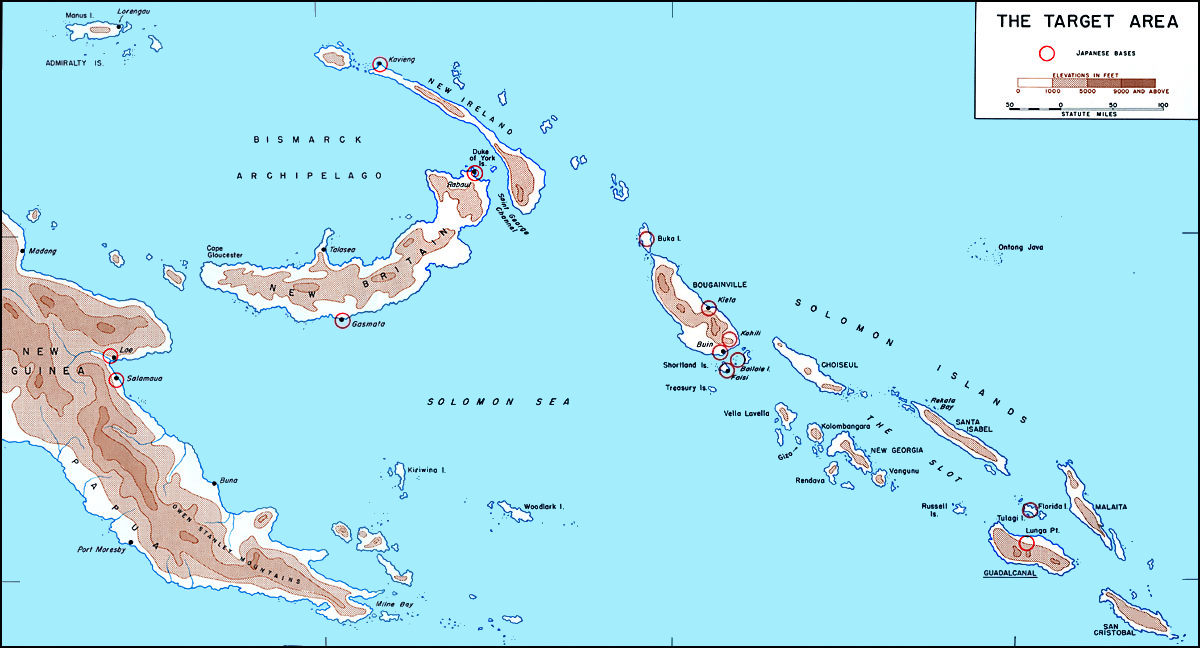 |
[  ] ]
Caribbean The US gunboat Erie (PG-50) is torpedoed by U-163 and is beached northwest of Willemstad, Curacao to prevent sinking.
[  | |   ] ]
Eastern Front In the Caucasus the Germans extricate 13th Panzer Division from a brief Soviet encirclement south of the Terek but are still under considerable pressure in this sector.
SOUTHERN SECTOR
Fighting rages unabated as the 6th Army pounds the 62nd Army. The Germans are already bogged down in costly, close-quarters fighting with the small and aggressive combat groups that simply refuse to give up. Luftwaffe reconnaissance over the Rumanian 3rd Army sector detects a build up of Soviet forces, which Fremde Heer Ost believes will be used for a limited counteroffensive against the Rumanian lines.
[  | |   ] ]
Guadalcanal The enemy pocket along Gavaga Creek is completely eliminated. The action has cost the Japanese 450 killed, and the few who have eluded the trap are being harassed while retiring toward Mount Austen, by Col Carlson's 2nd Raider Battalion marching west from Aola Bay.
The 1st Battalion, 164th Infantry, recrosses the Matanikau and the entire 164th Infantry goes into division reserve. Once back across the Matanikau, the bridges are destroyed and air and naval forces fight to keep the Japanese away.
The American advance stalls in the face of a strong Japanese counterattack. Carlson sends out 4 patrols to various points to make contact with other US units and the Japanese. Co E reports it has made contact with the 7th Marines at 1000 hours and learns a large Japanese force has escaped the trap and may be moving toward Binu. Company C calls 10 minutes later reporting a large Japanese force armed with machine guns, mortars and 20mm cannon is 3 miles southwest of Binu. Carlson moves his 3 other companies to attack and surround the Japanese. From various reports Carlson concludes the Japanese have split their force and are preparing a surprise attack on the rear of the 7th Marines. C Company runs into some Japanese in the woods on the edge of a broad field and are soon pinned down under machine gun, mortar and 20mm cannon fire. The company withdraws under covering fire of its own mortars. At 1630 Carlson arrives to find C Company disorganized. E Company is brought up to fight the Japanese, as C Company goes into reserve. Air support arrives at dusk and bombs are dropped in the woods. The Japanese force withdraws which Carlson soon discovers and withdraws his own force back to Binu arriving at 2300.
Transports and cargo ships from New Hebrides and New Caledonia arrive off Lunga Point and begin unloading. They withdraw at 1815 under destroyer escort after all the troops, totaling about 6,000 and including RCT 182 of the Americal Division, and part of the supplies are ashore, because of news that a heavy Japanese naval force, including 2 battleships, is moving south toward the island. Warships remain to engage the enemy.
[  | |   ] ]
|
Mediterranean - The British anit-aircraft ship Tynwald sinks on a mine off Bougie, Algeria with the loss of 20 crewmen.
- U-660 is preparing to attack convoy TE-3 when she is detected by the corvette HMS Lotus. Three depth charge attacks are made by Lotus before being replaced by Starwort. At 1059 the U-boat surfaces and surrenders before sinking stern first at 1105.
U-660|
| Class | Type VIIC |
| CO |
Kapitänleutnant Götz Baur |
| Location |
Mediterranean, N of Oran |
| Cause |
Depth charge |
| Casualties |
None |
| Survivors |
45 |
[  | |   ] ]
New Guinea The Australian 25th Brigade takes Gorari, while the Japanese manage to withdraw behind the Kumusi River without loss. The 2nd Battalion, 126th Regimet, US 32nd Division, moves toward Gora and Bofu. With Company E, in the lead, they reach Bofu. The 3rd Battalion of the 126th, upon reaching Pongani by air, starts toward Natunga.
[  | |   ] ]
North Africa
ALGERIA
Units of the British 1st Army, airborne troops dropped by US C-47s, take Bône, 150 miles east of Algiers. Commando units land near the harbor and seize it. Axis aircraft attack repeatedly during the day, hitting military and civil objectives. 2 companies of American airborne troops, attached to the British 1st Army, are dropped on Duzerville airport, 6 miles southeast of Bône, and occupy it. The Paratroop Task Force. consisting of the 60th Troop Carrier Group and the 2nd Battalion of the 509th Parachute Infantry, is placed under operational control of the British 1st Army at Algiers.
LIBYA
Units of British 1st and 7th Arm Divs enter Tobruk.
MOROCCO
The German U-boat U-130 sinks 3 American transports, the Tasker H. Bliss (AP-42) (12,569t), the Hugh L. Scott (AP-43) (12,479t) and the Edward Rutledge (AP-52) (9360t), off the coast of Morocco.
TUNISIA
The first German supply ships begin docking in Bizerta despite the efforts of the local French commanders to block the harbor and prevent this. Also landing at Bizerta and Tunis are units of Gen von Arnim's army.
[  | |   ] ]
United States, Home Front The draft age is lowered from 20 to 18. Roosevelt estimates that the US armed forces will embody nearly 10,000,000 men by the end of 1943.
[  | |   ] ]
Vichy France German troops take over Marseilles and reach the fortified area of Toulon, which the Germans announce will not be occupied.
[  | |   ] ]
|
Images from November 12, 1942
Japanese Planes Shot Down Off Guadalcanal
|
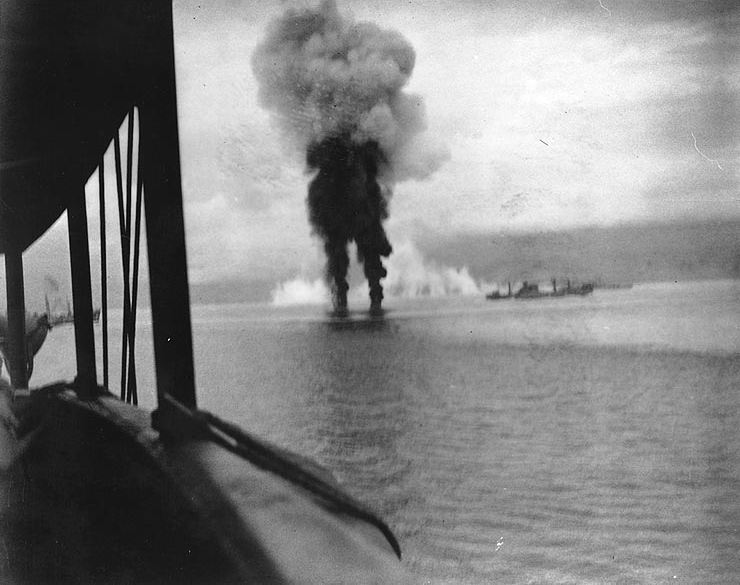 |
|
US Cruiser San Francisco Hit by Japanese Plane
|
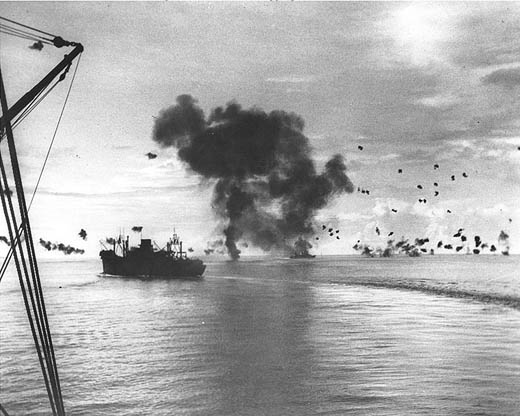 |
|
First Group of US Army Nurses To Go Overseas
|
 |
|
Sinking of American Freighters
|
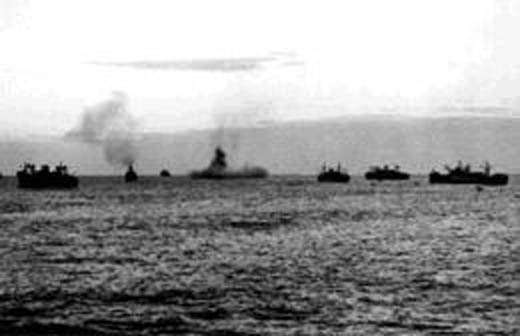 |
|
Sinking of American Freighters
|
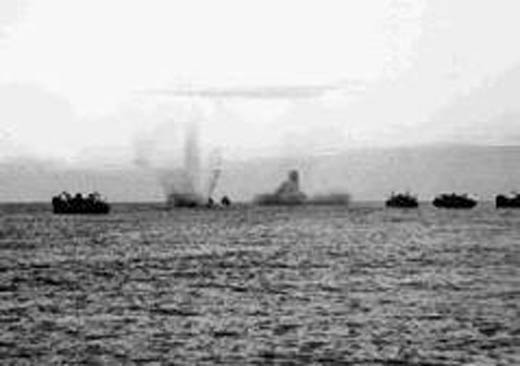 |
|
Friday, November 13
Air Operations, Europe
BOMBER COMMAND
Daylight Ops:
- 6 Wellingtons are sent to Emden where only 1 plane drops its bombs which hit fields; there are no losses.
- 2 Mosquitos of 105 Squadron are sent to Flushing to attack a damaged merchant ship, but do not return. It is believed that they do hit the ship again. 2 Mosquitos and 6 Bostons take off to carry out a sea search for the first 2 Mosquitos; they are not located and 1 of the Bostons is lost.
Evening Ops:
- 67 Lancasters and 9 Stirlings of the Pathfinder Force attack Genoa.
- It is a successful bombing raid, but there are no details.
Minor Ops:
- 12 Wellingtons lay mines of Lorient and St Nazaire without loss.
- Genoa is attacked by the RAF in a succession of night raids causing many casualties and severe damage to the city center.
[  | |   ] ]
Air Operations, North Africa Strong formations of the RAF Eastern Air Command land at Bône. The Luftwaffe carries out heavy counterattacks.
[  | |   ] ]
Air Operations, Solomons - Beginning at dawn, Cactus Air Force fighters and bombers mount numerous piecemeal attacks against the damaged Japanese battleship Hiei that is adrift off Savo Island. Among the many aircraft involved in the attacks are the first Marine Corps TBFs to see action in the war, elements of newly arrived VMSB-131. Also involved in the attacks are 14 of 25 11th Heavy Bomb Group B-17s taking part in fruitless search missions over New Georgia Sound.
- Marine Corps F4Fs shoot down as many as 10 A6M Zeros over New Georgia Sound during a morning search-and-strike mission against a nonexistent Japanese carrier battle group.
- V Bomber Command B-17s attack the Kahili airfield on Bougainville and ships in the Shortland Islands.
[  | |   ] ]
Naval Battle of Guadalcanal The Japanese send a large convoy of 11 transports carrying 11,000 men and escorted by Tanaka's 11 destroyers. To give cover to the operation and to bombard Henderson Field Adm Abe leads 2 battleships, 2 cruisers and 14 destroyers. The Japanese carriers are at sea farther to the north providing more protection. Adm Callaghan, with 5 cruisers and 8 destroyers, moves to intercept Abe's squadron.
|
Just before 2:00am the two forces blunder into each other. In an action lasting about half an hour almost all their other ships are damaged. The Americans lose 2 cruisers and 4 destroyers. Once more the Americans fail to make proper use of their radar equipment, partly because various ships have sets with different capabilities, and communications are poor. The Japanese transport convoy turns away.
The battleship Hiei, badly damaged during the night, is attacked repeatedly by American torpedo aircraft and dive-bombers near Savo Island. Damaged beyond repair she is scuttled by the Japanese.
During the night, Japanese warships are located by radar between Savo and Cape Esperance and a naval battle ensues during which 2 enemy destroyers are sunk and 4 damaged. The Japanese retire northward without having accomplished their mission of neutralizing Henderson Field before the arrival of the transport force. US losses are heavy: cruisers Atlanta and Juneau and destroyers Barton, Cushing, Laffey and Monssen are sunk; 5 others vessels are seriously damaged.[MORE]
[ | |  ] ]
Battle of the Atlantic - Hudson 'D' of No 500 Squadron attacks a surfaced U-boat with 4 depth charges which fell ahead of the boat as she was diving. No results were observed immediately, but subsequent analysis shows the U-411 was sunk in this attack.
U-411|
| Class | Type VIIC |
| CO |
Kapitänleutnant Johann Spindlegger |
| Location |
Atlantic, SW of Gibraltar |
| Cause |
Air attack |
| Casualties |
46 |
| Survivors |
None |
- The unarmed US schooner Star of Scotland (2290t) is shelled and sunk by U-159 while en route from Cape Town, South Africa to Paranagua, Brazil. 1 of the 17-man crew is lost when the ship is abandoned.
[  | |   ] ]
Eastern Front
SOUTHERN SECTOR
The battle for Stalingrad rages for the next few days as the German attacks begin to overwhelm the 62nd Army. With floating ice on the Volga, the Soviets have difficulty sending supplies across the river and the 62nd begins to run short of food and ammunition. The men cut off at Rynok and Spartakovka suffer badly, coming under sustained attack from the 16th Panzer Division. This group, commanded by Gorokhov, is down to just 300 men but continue to fight on. Chuikov is forced to admit that the end is in sight for the 62nd Army.
[  | |   ] ]
|
Guadalcanal 8 P-38s of the 339th Squadron, 347th Fighter Group, arrive at the fighter strip just east of Henderson Field after flying from Milne Bay.
[  | |   ] ]
Indian Ocean The US freighter Excello, sailing independently from Port Said, Egypt to Cape Town, South Africa, is torpedoed and sunk by U-181 with the loss of 1 crewman and 1 Armed Guard sailor.
[  | |   ] ]
Mediterranean U-431 sinks the Dutch destroyer Isaac Sweers 60 miles northwest of Algiers with the loss of 108 of her crew. 86 survivors are picked up by the British anti-submarine trawler Loch Oskaig.
[  | |   ] ]
New Guinea The Australians eliminate the Japanese rearguards near the Kumusi River. With the Japanese now back beyond the Kumusi River the safety of Port Moresby is ensured. Australian troops find evidence of cannibalism among the starving Japanese.
[  | |   ] ]
North Africa
ALGERIA
The Allied troops at Bône are reinforced by the landing of a parachute brigade, together with an infantry regiment and the advanced headquarters of the British 1st Army. The British 36th Brigade, 78th Division, has now passed Djidjelli, 40 miles east of Bougie, in their advance from Algiers. A formal agreement is signed by Adm Darlan and Gen Clark recognizing Darlan as head of the French civil government in North Africa. Gen Eisenhower flies to Algiers to meet Adm Darlan, who pledges the French Africa will be on the side of the Allies. The agreement is ratified by Eisenhower, Nogues and Juin. Giraud is to command the French armed forces.
LIBYA
The X Corps of the 8th Army takes Tobruk.
TUNISIA
Italian units from Libya join up with the Germans. The Axis forces occupy the Mareth Line, a fortified line somewhat boastfully called the 'African Maginot', built by the French for the protection of the eastern border of their colony.
[  | |   ] ]
World News
News of the World for November 13, 1942 (NBC Blue Network - News of the Day Audio)
|
Images from November 13, 1942
|
|
A Self-propelled Gun, The Bishop
|
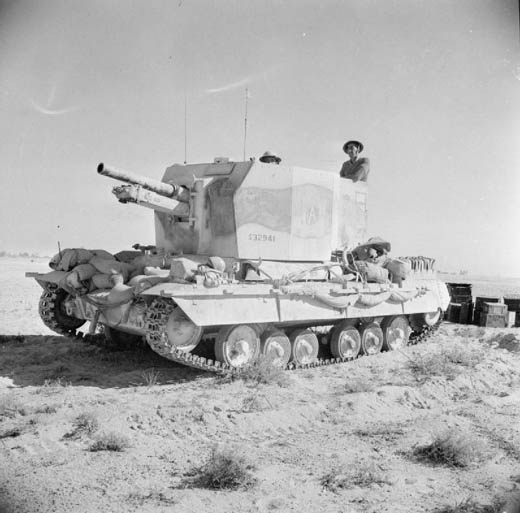 |
|
A Wounded German Officer
|
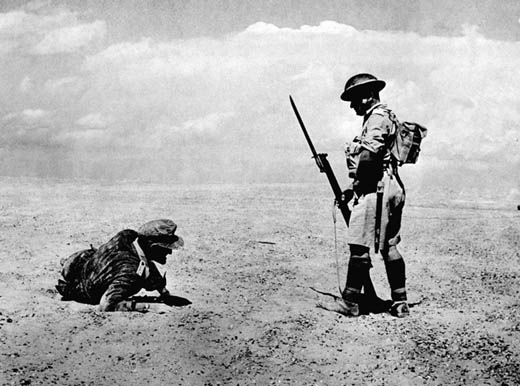 |
|
|
Saturday, November 14
Air Operations, Aleutians 1 28th Composite Bomb Group B-24 reconnoitering Kiska and Attu drops bombs on targets of opportunity at both locations.
[  | |   ] ]
Air Operations, Europe
US 8th AIR FORCE
FRANCE:
- Unable to locate the La Pallice U-boat base from above because of cloud cover, 15 VIII Bomber Command B-17s and 9 B-24s divert to their secondary target, the St.-Nazaire port area, where they dropped 57 tons of bombs.
[  | |   ] ]
Air Operations, New Guinea - 1 V Bomber Command B-25 attacks the track near Soputa.
- 374th Troop Carrier Group transports drop bridging equipment to Australian Army troops at Wairopi.
[  | |   ] ]
Air Operations, Solomons - Cactus Air Force SBDs locate the retiring Japanese Navy bombardment force in New Georgia Sound at 0630 hours, and a strike force composed of SBDs, TBFs, and F4Fs attacks it at 0800 hours. 1 heavy cruiser is severely damaged by bombs and another heavy cruiser is set afire by torpedoes. The Japanese Navy surface force is then tracked by 2 Carrier Air Group 10 SBDs from the USS Enterprise. Upon their departure for Henderson Field, the 2 SBDs attack one of the damaged heavy cruisers, and both score direct hits. Shortly, 2 more Carrier Air Group 10 SBDs attack an undamaged cruiser, but both miss the target. At 1020, a Carrier Air Group 10 strike force composed of 16 SBDs attacks the Japanese force. 1 light cruiser is heavily damaged, 1 heavy cruiser is lightly damaged, and 1 of the previously damaged heavy cruisers is sunk. The SBDs and 2 escorting F4Fs land at Henderson Field.
- 2 V Bomber Command B-17s, based in Australia, locate and attack the Japanese Navy transport force in New Georgia Sound at 0730 hours, and 2 Carrier Air Group 10 SBDs also locate the transports at about 0830 hours. Both SBDs miss targets with their bombs, and one is shot downed by escorting A6M Zeros. Cactus Air Force SBDs and VT-10 TBFs attack the transports at 1100 hours. The SBDs score hits on 3 transports and the TBFs hit 2 transports. 2 transports sink and a third turns back toward the Shortland Islands with 2 escort destroyers. No aircraft are lost. A second attack at 1445 hours by 13 Cactus Air Force and Carrier Air Group 10 SBDs hits 3 transports, of which one sinks outright. Another attack group composed of 8 VS-10 SBDs scores 4 direct hits, and a VS-10 SBD attacking on its own scores yet another direct hit. 15 11th Heavy Bomb Group B-17s attacking in two waves from high altitude between 1500 and 1515 hours score several near misses and apparently down several A6M Zeros. At 1530 hours, 10 Carrier Air Group 10 SBDs launched from the USS Enterprise score 4 hits and a near miss on 5 different transports, of which two sink immediately. An escorting VF-10 F4F downs 1 A6M Zero. In the last attack of the day, mounted at dusk, a mixed group of 14 Marine Corps and Navy SBDs and 4 bomb-laden VT-10 TBFs score 3 direct hits and sink yet another transport, the seventh of the day. Unfortunately, A6M Zero escorts down 3 Carrier Air Group 10 SBDs, and 2 pilots and 2 crewmen are lost.
|
- Through the day, in numerous engagements between 1100 hours and dusk, Marine Corps F4Fs and SBD gunners claim 21 A6M Zeros and F1M 'Pete' reconnaissance float planes downed over New Georgia Sound, and Carrier Air Group 10 F4Fs and SBD and TBF crews claim 8 Japanese Navy fighters downed over New Georgia Sound.
[  | |   ] ]
Eastern Front Further bitter fighting in Stalingrad after a comparative lull.
On the Caucasian fronts Berlin admits the initiative is in Russian hands.
[  | |   ] ]
New Guinea The Allies prepare to attack the Japanese beachhead in the area of Buna and Gona. Advance elements of the 126th Infantry, US 32nd Division are consolidating their positions at Natunga, and the Australian 2/6th Independent Company and the 128th Infantry of the US 32nd Division take up positions in the area of Embogu-Embi-Oro Bay. As the 5th Air Force drops bridging equipment, the Australian 25th Brigade puts up a pontoon bridge on the Kokoda track at Wairopi.
[  | |   ] ]
Naval Battle of Guadalcanal Tanaka turns south with his destroyers and transports early on the 14th and immediately comes under heavy air attack. 7 of the transports and 2 warships are lost. The attacking aircraft mostly come from Henderson Field but some are from the carrier Enterprise. Tanaka continues his advance, however, and during the night there is a further battle off Savo Island. The Japanese covering force is now led by Adm Kondo with the battleship Kirishima, 4 cruisers and 9 destroyers. The Americans have brought up TF64 (Adm Lee) with the battleships Washington and South Dakota and 4 destroyers. Shortly before midnight the engagement begins. South Dakota is hit and forced out of the battle but later a devastating 7-minute burst of fire from Washington sinks Kirishima. Control of the seas around Guadalcanal is now passing gradually to the Americans but in this case Tanaka's remaining transports manage to reach Tassafaronga.
Of the troops who have survived the earlier attacks more are killed while landing. After the defeat the Japanese are forced to make considerable use of submarines to transport supplies. Already many of their men are ill and hungry.
The Japanese continue attempts to neutralize Henderson Field with naval gunfire in preparation for landing reinforcements. An enemy cruiser-destroyer force opens fire early in the morning, but the bombardment is cut short by PT boats. A Japanese troop convoy sails from New Georgia to Guadalcanal. In the convoy are 11 transports and cargo ships and 12 escorting destroyers. The ships carry about 10,000 troops of the 229th and 230th Regiments of 38th Division, artillery men, engineers, replacement units, a naval force of between 1,000 and 3,500 men, weapons and 10,000 tons of supplies. A Southwest Pacific patrol plane spots the convoy at 0830, about 150 miles from Guadalcanal. Guadalcanal aircraft and the Enterprise air group, operating from Henderson Field, get ready to attack with torpedoes, bombs and machine guns. They strike throughout the day. 9 transports are hit, 7 sink while the 4 remaining afloat sail on toward Guadalcanal under cover of darkness. They unload about 4,000 troops and a few tons of supplies. Besides the transports, 1 enemy cruiser is sunk and 3 other warships are damaged.
|
In another effort to neutralize Henderson Field, the Japanese move a powerful warship force forward, Elements of Adm Kinkaids naval force intercept the enemy warships during the night and in a long-range gun battle sink a destroyer and badly damage the battleship Kirishima, which is scuttled by her crew. US losses in theis engagement are 3 destroyers sunk and 2 other warships damaged.[MORE]
[  ] ]
Mediterranean - U-605 is sunk in an air attack by Hudson 'B' of No 233 Squadron off Algiers.
U-605|
| Class | Type VIIC |
| CO |
Kapitänleutnant Herbert-Viktor Schütze |
| Location |
Mediterranean, N of Algiers |
| Cause |
Air attack |
| Casualties |
46 |
| Survivors |
None |
- U-595 is sighted by Hudsons 'C' and 'D' of No 608 Squadron and attacked with depth charges. The charges straddle the U-boat, which dives but resurfaces after a short time. She was so badly damaged she could not dive. The U-boat captain decided to beach her, but was being repeatedly attacked by the aircraft. She was finally beached near Ténès on the Algerian coast. The entire crew is captured by the French.
U-595|
| Class | Type VIIC |
| CO |
Kapitänleutnant Jürgen Quaet-Faslam |
| Location |
Mediterranean, W of Oran |
| Cause |
Air attack/beaching |
| Casualties |
None |
| Survivors |
45 |
[  | |   ] ]
North Africa
ALGERIA
The British occupy Bône harbor. The first tanker arrives on November 17.
TUNISA
The French commander, Gen Georges Barre, begins to move his troops away from the coastal towns in preparation for going over to the Allies.
[  | |   ] ]
Vichy France Axis fores surround the naval base at Toulon, where the French fleet is concentrated. Despite official denials, they are preparing a military coup.
[  | |   ] ]
|
Images from November 14, 1942
Japanese Warships Heading for Guadalcanal
|
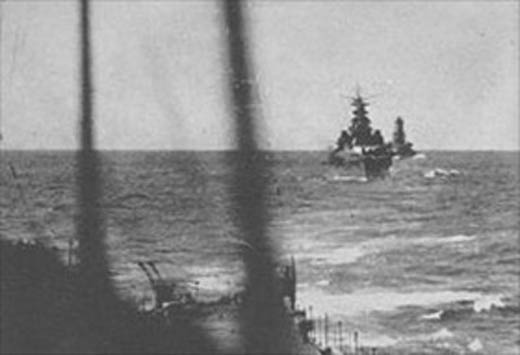 |
|
US Battleship Washington Firing on the Japanese
|
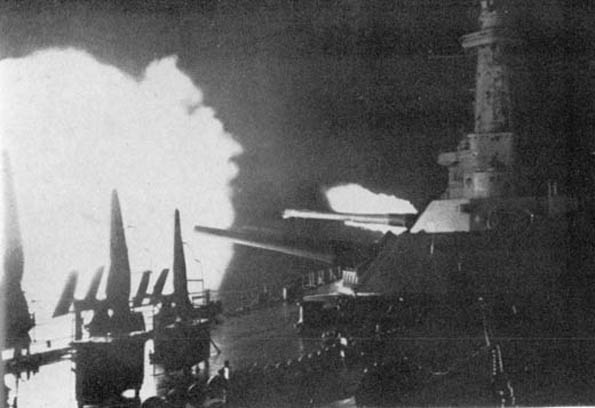 |
|
Breeches Buoy Is Put into Service
|
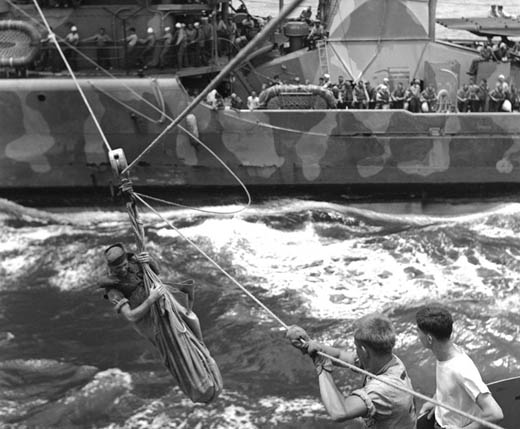 |
|
Bône Airfield after a Luftwaffe Raid
|
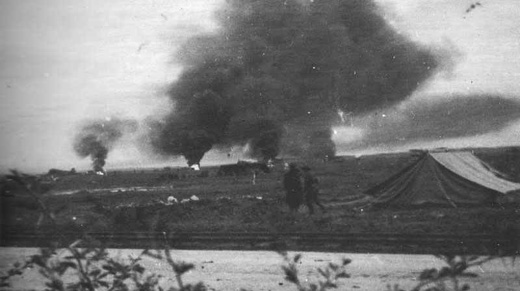 |
|
Sunday, November 15
Air Operations, Bismarcks V Bomber Command B-17s attack shipping at Rabaul.
[  | |   ] ]
Air Operations, Europe Hampdens of the Royal New Zealand Air Force attack shipping off the Norwegian coast.
BOMBER COMMAND
Evening Ops:
- 78 aircraft are sent to Genoa: 40 Halifaxes, 27 Lancaster and 11 Stirlings.
- The bombing is reported as accurate, but there are no details.
Minor Ops:
- 22 Wellingtons of 1 Group lay mines off La Pallice, Lorient and St Nazaire; 1 Wellington is lost.
[  | |   ] ]
Air Operations, Libya Two small formations of IX Bomber Command B-24s sent to attack Tripoli are prevented from reaching the target by bad weather. One group, however, attacks a motor convoy, an airdrome and road traffic.
[  | |   ] ]
Air Operations, New Guinea V Bomber Command B-25s and 22nd Medium Bomb Group B-26s attack anti-aircraft emplacements at Buna and Soputa and 3rd Light Bomb Group A-20s attack ground targets near Gona.
[  | |   ] ]
Air Operations, Solomons - Cactus Air Force and Carrier Air Group 10 bombers and fighters attack the 4 surviving Japanese Navy transports, which have been intentionally beached near the western end of Guadalcanal. Numerous hits are scored on the transports, which are reduced to hulks as the day progresses. This concludes the decisive Naval Battle of Guadalcanal, following which the Japanese Navyís Combined Fleet ceases to be a factor in the South Pacific campaign. After November 15, 1942, the Japanese commit no more transports and no warships larger than destroyers to the defense of Guadalcanal, and Japanese Navy aerial opposition falls to inconsequential levels.
- During the early morning, 2 VMF-121 F4Fs shoot down 2 A6M2-N 'Rufe' fighter-bombers over Guadalcanal, and VF-10 F4F pilots operating from Figther-1 airfield on Guadalcanal down 6 A6M Zeros or A6M2-N 'Rufes' over Guadalcanal at 1520 hours.
[  | |   ] ]
Atlantic - The British escort carrier Avenger, escorting Convoy MKF-1Y is sunk by U-155 about 120 miles northwest of Gibraltar. There are only 12 survivors of the 526-man crew. They are picked up by the Norwegian destroyer escort Glaisdale.
- The British anti-submarine whaler Ullswater (555t) is sunk by a German motor torpedo boat in the English Channel with the loss of 35 crewmen.
[  | |   ] ]
|
Battle of the Atlantic U-98 is sunk west of Gibraltar by depth charges from the British destroyer HMS Wrestler.
U-98|
| Class | Type VIIC |
| CO |
Oberleutnant zur See Kurt Eichmann |
| Location |
Atlantic, W of Gibraltar |
| Cause |
Depth charge |
| Casualties |
48 |
| Survivors |
None |
[  | |   ] ]
Britain, Home Front - Church bells ring throughout Britain to celebrate the victory of the 8th Army at El Alamein. The BBC broadcasts the sound of bells worldwide.
- On 'Civil Defense Day' the King inspects a parade of 1,500 in London.
[  | |   ] ]
Guadalcanal The last 4 of the 11 Japanese transports which should have landed reinforcements and materials on Guadalcanal are sighted at Tassafaronga, west of the American perimeter, and attacked by American aircraft and naval and land-based guns. Of the 4 surviving Japanese transports, 3 are beached and unloaded, while the 4th is slowly pulling northward toward Doma Reef. As the transports hit the beach, the men scramble over the sides with just their rifles and a little bit of rice. They begin climbing the mountain trail built by the Pioneer Forces, through the jungle to the main encampment of the Japanese command.
Battery F, 244th Coast Artillery Battalion, moves 2 of its guns from their positions on the west bank of the Lunga to the beach. At 0500 these 2 open fire and hit one of the beached transports 19,500 yards away. It begins to burn. 45 minutes later the 3rd Defense Battalion's 5-inch batteries open fire on a second ship 15,800 yards away and hit it repeatedly. The destroyer Meade sails over from Tulagi to shell both ships and landing areas. Before 0600 American planes look down on the grounded transports: Kinugawa Maru, Yamatsuki Maru, Hirokawa Maru, and Yamaura Maru. Adm Kusaka sends from Bougainville as many fighters as he can to protect the transports on the beach. The first raid scores hits on two of the transports. The second raid half an hour later hits more of them and a third at 0700 hits supplies on the beach. Five more attacks are made on the Japanese ships and they burn. Kusaka sends more Zeros but F4Fs engage them over Savo and claim 7 planes shot down to a loss of one. By noon all 4 are burning, useless hulks which are abandoned.
No more than 2,000 men are able to land; 2,000 more are killed on the beach, or trying to reach it. This is the last time the Japanese try to reinforce the island on any considerable scale. Japanese effectives on Guadalcanal at this time number about 20,000, though many of them are seriously ill with beri-beri and various forms of dysentery. There are about 23,000 Americans on the island.
Only 4,000 of the convoy's 10,000 troops land safely on Guadalcanal. Virtually no supplies make it, only 5 tons of the expected 10,000. Although some of the troops drown, many are rescued by the Japanese. The destruction of the convoy brings the November counteroffensive to an end.
|
Back at Nouméa Halsey can claim a clearcut victory. The Japanese had set out to land 10,000 men, plus the heavy equipment, big guns and ammunitioin for an entire infantry division. Only about 2,000 actually get ashore, with 1,500 bags of rice, 4 days supply, and 260 rounds of ammo for the mountain guns. The cost to the Japanese: 2 battleships, 1 heavy cruiser, 3 destroyers, 77,609 shipping tons in the 11 transports and about 50 planes plus 6 damaged warships. The Americans landed the 8th Marine Regiment from 4 transports which had then retired. American losses: 2 cruisers, 7 destroyers and serious damage to 3 cruisers and lighter damage to a battleship. It is costly for both sides, but the Americans have the best of it.
[  | |   ] ]
Mediterranean - The British minesweeper Algerine is sunk by the Italians submarine Ascianghi off Bougie, Algeria with the loss of 80 of her crew.
- Hudson 'S' of No 500 Squadron attacks a surfaced U-boat, U-259. The rear gunner reports the submarine blew up. The aircraft was badly damaged by the explosion and the crew was forced to bale out.
U-259|
| Class | Type VIIC |
| CO |
Kapitänleutnant Klaus Kopke |
| Location |
Mediterranean, off Algiers |
| Cause |
Air attack |
| Casualties |
48 |
| Survivors |
None |
- In naval action off North Africa, the US cargo ship Electra (AK-21) (8113t) is torpedoed by U-173 and the US cargo ship Almaack (AK-27) (6736t) is torpedoed by U-155.
[  | |   ] ]
New Guinea Having built rudimentary bridges over the Kumusi the Australians are able to advance to take Wairopi and Ilimow.
[  | |   ] ]
North Africa
ALGERIA
The British 36th Brigade, 78th Division, of the 1st Army crossed the Tunisian frontier and captures Tabarka, on the coast about 75 miles from Tunis. The 2nd Battalion, 509th Parachute Regiment, takes Youks-les-Bains, near Tébessa in Algeria, about 95 miles south of Bône.
LIBYA
The British X Corps occupies Martuba airfield.
TUNISIA
The German buildup has been very rapid and there are now 10,000 troops taking up positions in Tunisia. They have over 100 combat planes in bases long established by the French, convenient for the front and with all-weather runways. The Allied air forces are forced to use temporary landing grounds farther from the front.
[  | |   ] ]
|
Images from November 15, 1942
Japanese Transports On Fire
|
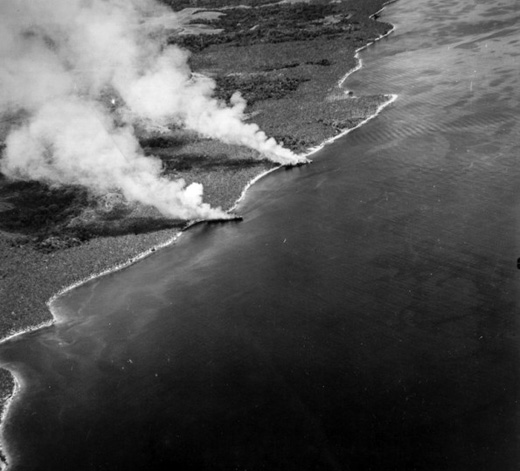 |
|
Australian Troops Loading Guns
|
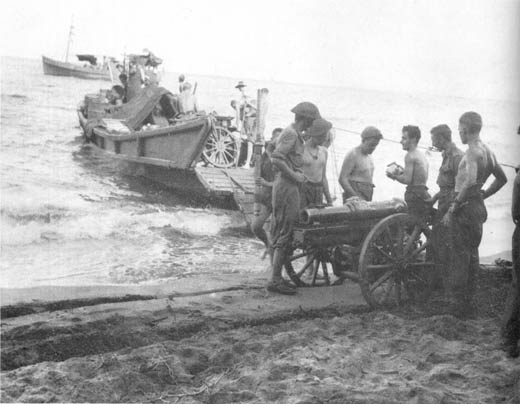 |
|
Refuelling a Stuart Tank
|
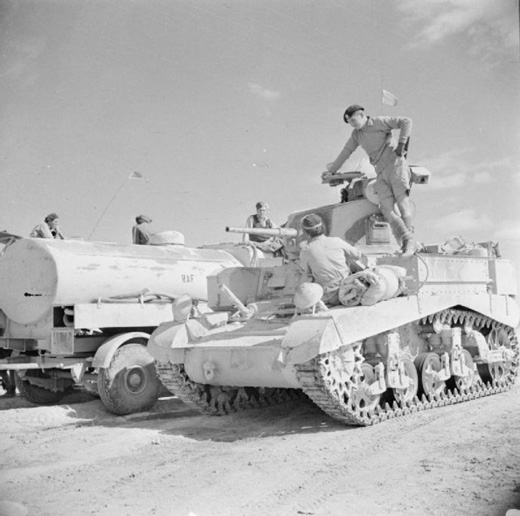 |
|
Monday, November 16
Air Operations, Aleutians XI Bomber Command reconnaissance bombers drop demolition charges on targets on Attu and Kiska islands.
[  | |   ] ]
Air Operations, Europe
BOMBER COMMAND
Daylight Ops:
- 6 Mosquitos bomb targets in the small towns of Emmerich, Jüich and Lingen without a loss.
Minor Ops:
- 65 aircraft lay mines in various places from Lorient to the Frisians; 2 Wellingtons and 1 Stirling are lost; 5 Halifaxes make leaflet flights over France without a loss.
US 8th AIR FORCE
FRANCE:
4 4th Fighter Group Spitfires are dispatched to strafe targets of opportunity along the French coast.
[  | |   ] ]
Air Operations, Far East US bombers raid Bangkok.
[  | |   ] ]
Air Operations, New Guinea V Bomber Command B-25s, 22nd Medium Bomb Group B-26s, and 3rd Light Bomb Group A-20s operating in support of the US 32nd Infantry Division attack numerous targets at Buna, Giruwa, Gona, Sanananda, and Soputa, including landing barges, troop concentrations, and anti-aircraft emplacements.
[  | |   ] ]
Air Operations, Tunisia 6 B-17s from the 97th Heavy Bomb Group's 340th Heavy Bomb Squadron attack Bizerte's Sidi Ahmed Airdrome, the first heavy-bomber mission flown by a XII Bomber Command unit.<.p>
[ ] ]
Mediterranean - The Greek submarine Triton is sunk by the German auxiliary submarine chaser UJ-2102 in the Aegean Sea off Kafirea, Euboia Island.
- The British submarine Safari sinks the German steamer Hans Arp (2645t) near Benghazi.
|
- U-173 is sunk in a depth charge attack by the US destroyers Woolsey (DD-437), Swanson (DD-443) and Quick (DD-490).
U-173|
| Class | Type IXC |
| CO |
Oberleutnant zur See Hans Schweichel |
| Location |
Mediterranean, off Casablanca |
| Cause |
Depth charge |
| Casualties |
57 |
| Survivors |
None |
[  | |   ] ]
New Britain The Japanese establish the headquarters of the 8th Army under Gen Hitoshi Imamura at Rabaul. Operating under him also are the 17th Army in the Solomons and the 18th Army in New Guinea.
[  | |   ] ]
Guadalcanal The 4 surviving transports of the Japanese convoy are sighted at Tassafaronga and attacked by artillery, naval gunfire and aircraft from Henderson Field and New Hebrides. All 4 are destroyed and supplies on the beach are fired. The decisive defeat almost isolates the Japanese on Guadalcanal.
Four Japanese Transports Burning at Tassafaronga
|
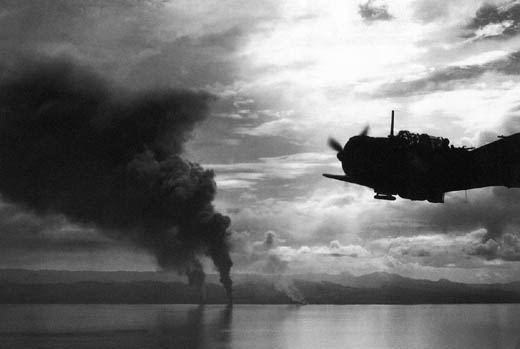 |
[  | |   ] ]
New Guinea The Australians and the Americans begin operations against the Japanese beachhead in the Buna-Gona area. The American 32nd Division advances on Buna and the Australian 7th Division moves on Gona and Sanananda. The Allies had expected to find the Japanese disorganized and demoralized, but instead thay are quite ready to put up a vigorous difense, favored by the broken terrain and a line of strongpoints. The Japanese troops are commanded by Col Yosuke Yokoyama, west of the Girua River, and by Capt Yoshitatsu Yasuda east of the river. Gen Horii has disappeared during the retreat from the Kokoda track. The American landing south of Buna is held up by Japanese aircraft.
In the Australian 7th Division sector on the west, the 25th Brigade moves toward Gona and the 16th toward Sanananda. To the east, the US 32nd Division's 126th Infantry heads for Buna along the axis Inonda-Horanda-Dobodura, and Warren Force (based on the 128th Infantry) moves along the coast toward Cape Endaiadere. Although by evening Australian artillery is employed to support the coastal advance, Warren Force suffers a severe blow when small craft bringing urgently needed supplies are destroyed by enemy planes. Among personnel embarked on these is Maj-Gen Edwin F. Harding, CG of the US 32nd Division, who swims ashore.
[  | |   ] ]
|
North Africa
TUNISIA
The whole country is now occupied by Axis troops. Several thousand German troops form a bridgehead in the Bizerte-Tunis area. The British 1st Parachute Battalion takes Souk el Arba, 30 miles south of Tabarka. The British 36th Brigade farther north takes Djebel Abiod. Late in the day the paratroops have reached nearly to Beja. The first engagements between French and German troops take place at Oued Zarga, Mateur and the road between Beja and Djebel Abiod. The French forces drive off the German patrols.
Gen de Gaulle announces that he and his Free French supporters do not accept Darlan's authority. Many British politicians are worried, too, about cooperating with a former member of the Vichy government. The Americans have been always much more ready to favor Vichy than the British and, therefore, see nothing wrong with such a useful arrangement.
First Actions in Tunisia, November 16-23, 1942.
|
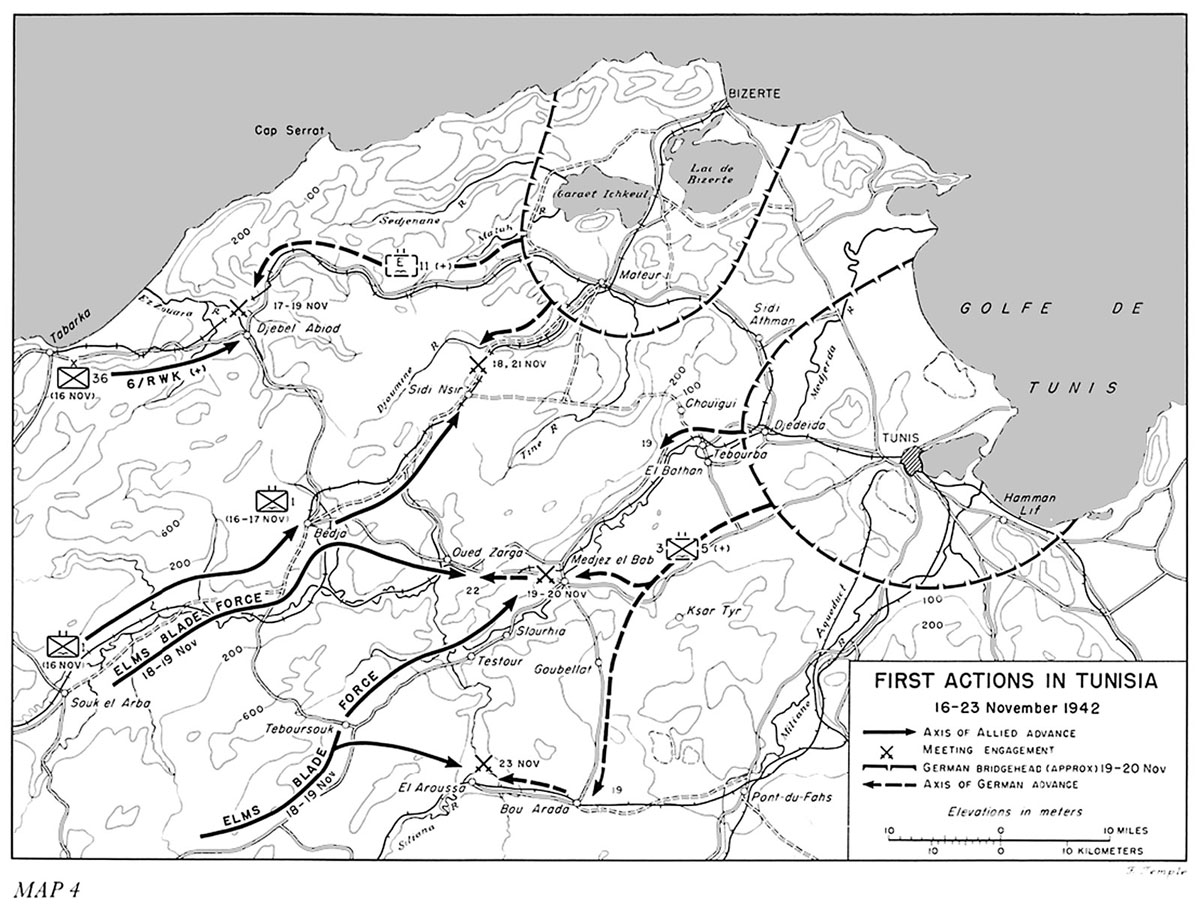 |
[  | |   ] ]
Pacific - The US submarine Haddock (SS-231) sinks the Japanese merchant cargo ship Nichinan Maru (1945t).
- The US submarine Seal (SS-183) sinks the Japanese army cargo ship Boston Maru (5477t) off Palaus, but is damaged when rammed by another enemy vessel ending her patrol.
[  | |   ] ]
|
Tuesday, November 17
Air Operations, Bismarcks 38th Medium Bomb Group B-25s attack Gasmata, 90th Heavy Bomb Group B-24s attack Rabaul and 1 V Bomber Command B-17 attacks the Rabaul dock area.
[  | |   ] ]
Air Operations, Europe
BOMBER COMMAND
Minor Ops:
- 43 aircraft lay mines from Lorient to the Frisians; 14 aircraft make leaflet flights over France.
- 1 Halifax is lost on the leaflet operation.
US 8th AIR FORCDE
FRANCE:
- Of 63 VIII Bomber Command heavy bombers dispatched, 35 B-17s and B-24s attack the St.-Nazaire U-boat base with nearly 94 tons of bombs. Bomber gunners claim 6 Luftwaffe fighters downed along with 8 probables.
- 16 bombers are damaged; 1 crewman killed, 3 wounded
- 16 B-17s of the 303rd Heavy Bomb Group, in its combat debut, fail to find their target. 6 44th Heavy Bomb Group B-24s also fail to find their target, the Cherbourg/Maupertus Airdrome, due to solid cloud cover. The 305th Heavy Bomb Group makes its combat debut when it sends 10 B-17s on a diversiionary flight.
[  | |   ] ]
Air Operations, New Guinea 22nd Medium Bomb Group B-26s attack Gona in support of US and Australian ground forces while B-25s attack the airfield at Lae.
[  | |   ] ]
Burma Gen Wavell decides to cancel the proposed major amphibious operation against Akyab and instead, on November 19 issues orders for a more limited advance by 14th Indian Division down the Mayu Peninsula perhaps to be followed by a shorter seahorse operation against Akyab.
[  | |   ] ]
|
Eastern Front
SOUTHERN SECTOR
In Stalingrad, the German assaults are annihilating the 62nd Army. The group at Tynok and Spartakovka has been reduced to 300 troops at the hands of the 16th Panzer Division. Another problem now besets the Soviets: ice on the Volga. Ice on the river stopped boat traffic three days ago, as the river was impassable.
Efforts to air-drop supplies to the 62nd Army have come to nothing, because the Red Army has such a slender strip of land and most of the material falls into German hands. Luftwaffe reconnaissance has detected Soviet build-ups to the northwest of the city, which worry Paulus.
[  | |   ] ]
Malta Over the next 4 days a convoy, code named STONEAGE, passes from Gibraltar to the island. None of the 4 freighters is lost and of the 3 cruisers and 10 destroyers which form the escort, only one vessel a hit. The long period of heavy attacks on the stand is over and the siege has come to an end.
[  | |   ] ]
Mediterranean - The British submarine Utmost is sunk by the Italian torpedo boat Groppo northwest of Marittimo, Italy with the loss of the entire crew of 33.
- U-331 is sighted on the surface by Hudson 'Z' of No 500 Squadron which drops four depth charges from a height of 20 feet inflicting severe damage. Two more Hudsons joined the attack until the U-boat indicated it was surrendering.
U-331|
| Class | Type VIIC |
| CO |
Kapitänleutnant Hans Dietrich Freiherr von Tiesenhausen |
| Location |
Mediterranean, off Cape Casine |
| Cause |
Air attack |
| Casualties |
32 |
| Survivors |
17 |
[  | |   ] ]
|
New Guinea The Australians and the Americans continue to advance closer to the Buna-Gona beachhead. The US 32nd Division's Warren Force suffers another setback as Japanese planes put 2 more supply luggers out of action, leaving ony 1 serviceable and necessitating the supply of vital items by air until more luggers become available. A Japanese convoy of destroyers lands 1,000 fresh troops at Basabua in the evening. The Japanese positions around Gona, Buna and Sanananda have been strongly fortified since September and are now well garrisoned also.
[  | |   ] ]
North Africa
LIBYA
The vanguard of 8th Army has reached Derna on the coast and Mechili inland.
MOROCCO
British paratroopers land at Souk-el-Arba airfield, commandeer French motor transport and leave at top speed for Bizerta.
TUNISIA
The 36th Brigade of the British 78th Division makes contact with the Germans west of Djebel Abiod, about 60 miles west of Tunis. The British 1st Army commander orders the 78th Division to concentrate for the advance on Tunis. Further south the 2nd Battalion, 509th Parachute Regiment, takes the Gafsa airport.
[  | |   ] ]
Pacific - The US submarine Searaven (SS-196) sinks the Japanese transport Nissei Maru (833t) in Flying Fish Cove off Christmas Island.
- The US submarine Salmon (SS-182), attacking a Japanese convoy off the west coast of Luzon, sinks the repair ship Oregon Maru (5873t) about 65 miles northwest of Manila.
[  | |   ] ]
|
Images from November 17, 1942
|
|
64th Bomb Squadron Crew at Mareeba, Queensland, Australia
|
 |
|
Soviet Prisoners Captured in the Caucasus
|
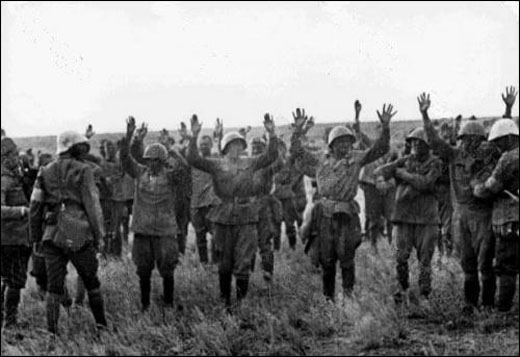 |
|
|
Wednesday, November 18
Air Operations, Bismarcks V Bomber Command B-17s attack shipping near Gasmata.
[  | |   ] ]
Air Operations, Europe
BOMBER COMMAND
Evening Ops:
- 77 aircraft make an attack on Turin.
- Many fires are started in the center of the city; the Fiat motor factory is also hit; 42 people are killed and 72 injured.
Minor Ops:
- 5 OTU aircraft make leaflet flights over France without a loss.
- During the night British bombers hit Turin.
US 8th AIR FORCE
FRANCE:
- 21 91st and 306th Heavy Bomb Group B-17s attack La Pallice U-boat base, as planned, while 19 303rd Heavy Bomb Group B-17s mistake St.-Nazaire for La Pallice and drop their bombs there. St.-Nazaire is more than 100 miles from La Pallice. In separate action, 13 93rd Heavy Bomb Group B-24s attack Lorient.
- 1 B-17 is missing; 1 B-24 is damaged beyond repair, 3 B-24s and 24 B-17s are damaged; 6 crewmen killed, 14 wounded
- 2 4th Fighter Group Spitfires destroy a locomotive while on a strafing mission.
[  | |   ] ]
Air Operations, Libya 376th Heavy Bomb Group B-17s attack the marshalling yard and port area at Benghazi.
[  | |   ] ]
Air Operations, New Guinea - V Bomber Command B-25s attack the airfields at Lae and Salamaua.
- 22nd Medium Bomb Group B-26s attack the area between Buna and Cape Endaiadere.
- V Bomber Command B-17s attack Japanese Navy ships near Buna, Gona, and Cape Ward Hunt.
[  | |   ] ]
Air Operations, Solomons - 11 5th and 11th Heavy Bomb Group B-17s and 4 70th Medium Bomb Group B-26s, with 8 339th Fighter Squadron P-38 escorts, attack shipping at Buin. When the lead B-17 is mortally damaged and its pilot and co-pilot are killed by an A6M Zero, Col La Verne G. Saunders, the 11th Group commanding officer, takes the controls and eventually lands in the water near Baga Island. All the living crewmen are rescued by a US Navy PBY.
- 2 339th Fighter Squadron P-38s down 3 A6M Zeros over Tonolei Harbor at 0830 hours. These are the first victories credited to P-38s in the South Pacific Area.
[  | |   ] ]
|
Battle of the Atlantic - German submarines attack the west-bound Convoy ONS-144. The US freighter Parismina (4732t) is torpedoed and sunk by U-624. 15 crewmen, 2 Armed Guard sailors and 3 passengers are lost in the attack. The British rescue ship Perth and the Dutch-manned corvette Rose rescues the 55 survivors. The US freighter Yaka (5432t) is also of victom of U-624 and is abandoned. All 52 on board are rescued by the Canadian corvette Vervain.
- The US tanker Brilliant (9131t), in Convoy SC-109, is torpedoed by U-43. An intense fire breaks out as 8 on board take to a lifeboat only to lose 2 to drowing when the boat is swamped. Those remaining on board the tanker put out the fire and proceed back to Newfoundland.
[  | |   ] ]
Eastern Front The Russians are about to launch a huge offensive against the German forces at Stalingrad. In Stalingrad itself are the German 6th Army and part of the 4th Panzer Army. Southwest of the city is Army Group B, under Gen Maximilian von Weichs, with part of the 4th Panzer Army and the Rumanian 4th Army. Further north, in the great bend of the Don, are the Italian 8th Army and the Rumanian 3rd Army. On the Russian side, north of the Don and as far as the bridgehead at Kletskaya, beyond the river, is the Southwest Front commanded by Gen Vatutin and comprising the 1st Army, the 5th Tank Army and the 21st Army. Between Kletskaya and Stalingrad is deployed the Don Front under the command of Rokossovsky, made up of the 65th, the 24th and the 66th Armies. From Stalingrad to the south is the Stalingrad Front, commanded by Yeremenko and comprising part of the 62nd Army under Gen Zhukov, the 64th Army, the 57th Army under Tolbukhin and the 51st Army under Gen Nikolai Trufanov.
SOUTHERN SECTOR
The eve of Operation URANUS. The Stavka has amassed the following forces for the offensive: Southwestern Front (1st Guards, 21st and 5th Tank Armies, III Guards Cavalry and IV Tanks Corps, and 17th and 2nd Air Armies) 398,000 troops, 6,500 artillery pieces, 150 Katyushas, 730 tanks and 530 aircraft; Don Front (24th, 65th and 66th Armies and 16th Air Army) 307,000 troops, 5,300 artillery pieces, 150 Katyushas, 180 tanks and 260 aircraft; and Stalingrad Front )51st, 57th, 62nd and 64th Armies, IV and XIII Mechanized Corps, IV Cavalry Corps and 8th Air Army) 429,000 troops, 5,800 artillery pieces, 145 Katyushas and 650 tanks. Facing the Don and Southwestern Fronts is the Rumanian 3rd Army (100,000 troops), while the Rumanian 4th Army (70,000 troops) faces the Soviet 51st and 57th Armies. These are extremely weak formations to have as flank protection for the 4th Panzer and 6th Armies at Stalingrad.[MORE]
[  | |   ] ]
Guadalcanal Gen Edmund Sebree, CG SW Sector, begins moving forces toward a line of departure west of the Matanikau River (from Point Cruz southward along the ridge containing Hills 80,81 and 66) in preparation for a full-scale westward offensive. The 2nd Battalion, 182nd Infantry, covered by the 8th Marines, which remains east of the Matanikau, crosses the river about 700 yards from its mouth and takes Hill 66, southernmost point of the line of departure.
There is little air activity. 3 Zeros are shot down by newly arrived P-38s.[MORE]
[  | |   ] ]
|
New Guinea The Australian 16th Brigade takes Popondetta, where orders are given for the immediate construction of a landing strip, and pushes on toward Soputa without making contact with the enemy. The US 32nd Division's 126th Infantry is ordered to establish contact with the Australians. Because of supply problems, Warren Forces remains in place.
[  | |   ] ]
North Africa
LIBYA
The 8th Army captures Cyrene, Libya.
TUNISIA
The 36th Brigade of the British 78th Division at Djebel Abiod drives off a German attack, but east of this position the 11th Brigade, Hart Force, is cut off in the region east of Djebel Abiod. The Germans also attack the French XIX Corps at Medjez el Bab, 35 miles southwest of Tunis and 30 miles south of Mateur. The parachute force is now at Sidi Nsir.
Members of the Italo-German Armistice Commission
|
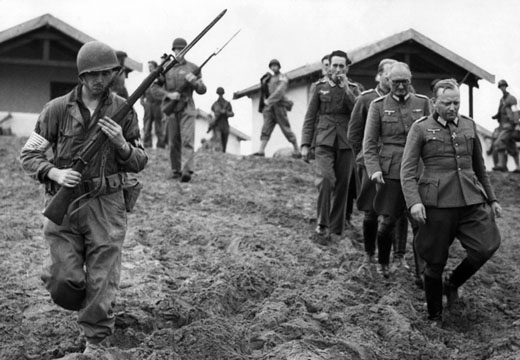 |
[  | |   ] ]
Pacific The British submarine Trusty sinks the Japanese army cargo ship Columbia Maru (5168t) off Penang, Malaya.
[  | |   ] ]
Vichy, Politics Pétain grants power to Laval allowing him to issue decrees solely on his own authority. Pétain is gradually becoming less and less important in the Vichy government, although his enormous prestige remains.
[  | |   ] ]
|
Thursday, November 19
Air Operations, Europe
BOMBER COMMAND
Evening Ops:
- 11 Wellingtons of 1 Group lay mines off Lorient and St Nazaire.
US 8th AIR FORCE
NETHERLANDS:
A 4th Fighter Group Spitfire downs an FW-190 fighter off Flushing during a shipping patrol over the North Sea.
[  | |   ] ]
Air Operations, Tunisia B-17s ot the 97th Heavy Bomb Group's 340th Heavy Bomb Squadron, escorted by 14th Fighter Group P-38s, attack Tunis/El Aouina Airdrome, destroying 8 Axis aircraft on the ground.
[ | |  ] ]
Battle of the Atlantic Adm Horton takes over the British Western Approaches Command from Adm Sir Percy Noble. Although Noble has been an able leader, he does not have the forceful spirit which Horton brings to the job. The German U-boat leaders soon notice the change. Dönitz will write later that Horton's appointment made a substantial difference.
[  | |   ] ]
New Guinea Forward elements of the Australian 25th Brigade encounter the enemy one mile south of Gona. The Australian 16th Brigade makes contact with the Japanese just outside Soputa. After establishing contact with the Australians near Popondetta, the 126th Infantry, US 32nd Division, heads for Buna but, since the Japanese appear to be concentrated west of the Girua River, is directed to assist Maj-Gen George A. Vasey's Australian 7th Division instead. Gen Harding thus loses half his assault force, exposing the left flank of Warren Force. The 1st and 3rd Battalions of the 128th Infantry, Warren Force, attack in parallel columns, the 1st Battalion from Boero and the 3rd Battalion from Simemi. Both run into acurate enemy fire from concealed positions and suffer heavy casualties. A maximum gain of 200 yards is made on the right along the coast.
[  | |   ] ]
|
Eastern Front The Soviet winter offensive, called Operation URANUS, begins along the Don. The German forces throughout the southern Soviet Union are hopelessly overextended. Stalingrad has drawn German troops like moths to a candle while both to their left and right are unreliable allies. The Soviets have been planning a grand attack with fresh divisions for weeks. They intend a pincer move with armies from the Southwest Front, under Vatutin, and the Don Front, under Rokossovsky, attacking southward from the Don, especially between Kletskaya and Kotovskiy, and the Stalingrad Front, under Yeremenko, whose armies are to attack from south of the city. Zhukov is in overall command. Only the northern claw of the pincer attacks at this stage. The Soviets have assembled more than 500,000 infantry, 900 new T34 tanks, and have the support of masses of artillery and over 1,000 attack planes. The units deployed in the northern pincer are 5th Tank Army, 21st Army and parts of 1st Guards Army. The unfortunate victims are 7 divisions of the Rumanian 3rd Army who come under murderous pressure and can do little to prevent a major breakthrough around Kletskaya.
At 8:50am, after a murderous artillery preparation, the Russians launch their great counteroffensive at Stalingrad. For the Germans this is the beginning of a colossal disaster. 6 corps of the Don Front move from the Kletskaya bridgehead beyond the Don, 75 miles northwest of Stalingrad. Further north the armies of the Southwest Front are advancing from Serafimovich on the Don, about 95 miles northwest of Stalingrad. The Germans and Rumanians hold out fairly well everywhere, except that a powerful Russian penetration is immediately reported in the Kletskaya area. Gen Maximilian von Weichs, commanding Army Group B, orders an immediate counterattack, but all that results is temporary containment of the enemy.
In the Caucasus the Germans are in trouble also. The Soviets win an important engagement near Ordzhonikidze. Bad weather largely ends major operations here but the Soviets manage a series of small gains in the next few weeks.
SOUTHERN SECTOR
Operation URANUS begins as the Southwestern and Don Fronts attack the Rumanian 3rd Army. The Rumanians defend stoutly and at first the Soviet 5th Tank, 21st and 65th Armies make slow progress. However, an assault by the I and XXVI Tank Corps of the 5th Tank Army eventually rips a hole in the Rumanian front, through which the Soviets pour. By the end of the day the Rumanians have suffered a staggering 55,000 casualties. The German XLVIII Panzer Corps is ordered to restore the situation, but attacks by the Rumanain 1st Armored Division north of Zhirkovski and 22nd Panzer Division from Peschany are costly failures. Paulus, ordered to restore his northern flank, decides to employ his three panzer divisions.[MORE]
[  | |   ] ]
|
Guadalcanal The 1st Battalion, 182nd Infantry, under Lt-Col Francis F. MacGowan, crosses the Matanikau and advances along flat ground between the northernmost hills and the beach, while B Company, 8th Marines, advances over the most northerly hill (Hill 78) to cover the battalion's left flank. About 400 yards west of the river the battalion meets fire from small enemy groups but continues its slow movement toward Point Cruz. About noon the battalion halts just east of Point Cruz, digs in along 700-yard line from the beach east of the point to the west tip of Hill 78. B Company withdraws back across the river to rejoin its regiment. The 1st and 2nd Battalions of the 182nd Infantry are separated by a gap of over 1,000 yards. During the night the Japanese move forward from Kokumbona and open fire on the 1st Battalion.
[  | |   ] ]
North Africa
LIBYA
The British 8th Army enters Benghazi.
TUNISIA
British paratroopers advancing from Souk-el-Arba encounter Germans at Sidi Nzir, southwest of Bizerta.
Gen Louis Jacques Barré of the French XIX Corps rejects a German ultimatum that they abandon Medjez el Bab as they continue to resist German attacks. During the day the French troops are reinforced by the British and Americans. The Germans, now led by Gen Nehring, have brought forward tanks and infantry, but are forced to retire in the face of the reinforced Allies. Gen Barré openly joins the Allies.
[  | |   ] ]
|
Images from November 19, 1942
|
|
Russian Troops Counterattack
|
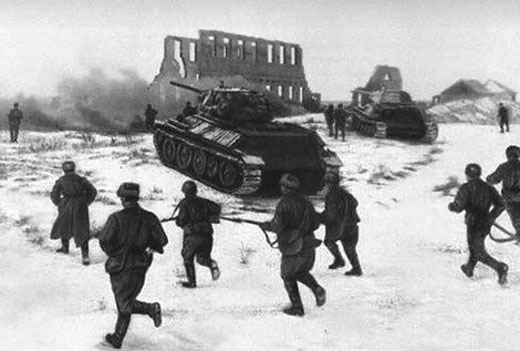 |
|
Stuart Tanks in Benghazi
|
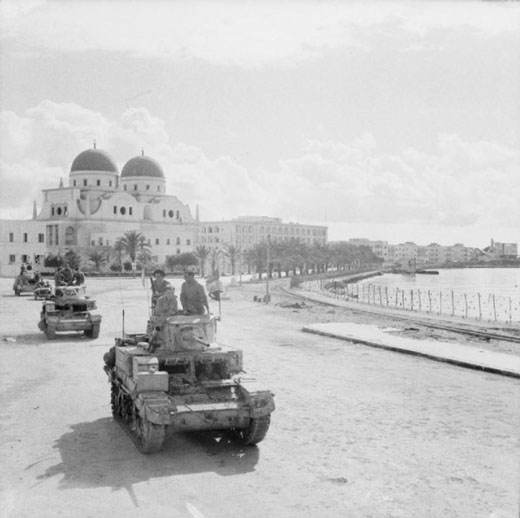 |
|
|
Friday, November 20
Air Operations, Algeria During the night, approximately 30 Luftwaffe Ju-87 dive-bombers and Ju-88 medium bombers, apparently from bases in Sardinia, attack the Algiers/Maison Blanche Airport for two hours and destroy on the ground 2 P-38s, 1 B-17, 4 RAF Recon Spitfires and 3 RAF Beaufighters.
[ ] ]
Air Operations, CBI 8 B-24s of the 7th Heavy Bomb Group's 436th Heavy Bomb Squadron attack marshaling yards at Mandalay, Burma.
[  | |   ] ]
Air Operations, Europe
BOMBER COMMAND
Evening Ops:
- 232 aircraft are sent to attack Turin: 86 Lancasters, 54 Wellingtons, 47 Halifaxes and 45 Stirlings.
- The attack is successful with large fire being started; dense smoke prevents further observations of the bombing results; 117 people are killd and 120 injured.
- 1 Halifax, 1 Stirling and 1 Wellington are lost.
Minor Ops:
- 4 Stirlings lay mines in the Gironde River and there are 4 OTU sorties.
[  | |   ] ]
Battle of the Atlantic U-184 is shadowing convoy ONS-144 when she is attacked and sunk early in the morning by the Norwegian-manned corvette HMS Potentilla.
U-184|
| Class | Type IXC/40 |
| CO |
Kapitänleutnant Günther Dangschat |
| Location |
Mid-Atlantic |
| Cause |
Depth charge |
| Casualties |
50 |
| Survivors |
None |
[  | |   ] ]
Eastern Front While fighting rages in and north of Stalingrad, a new large-scale attack by the Russians get under way from Beketovka and Plodovitoye, south of the city. The southern claw of the Soviet pincer around Stalingrad begins its attacks. The attacking units are the 51st, the 64th and the 57th Armies along with several armored and mechanized corps. The principal victims here are the Rumanian 4th Army and part of the German 4th Panzer Army, the other part is in the city and will be surrounded. The Russian forces are subdivided into the 'Don' group, attacking from the north and the 'Volga', attacking from the southeast. The attack is held up for a time by energetic counterattacks by the 29th Panzergrenadier Div, but eventually the Soviet numbers tell.
|
SOUTHERN SECTOR
The Rumanian 1st Armored Division is destroyed by the Soviet 5th Tank Army, which also mauls the 22nd Panzer Division as it falls back to the Chir. At Stalingrad a fuel shortage delays the advance of the XIV Panzer Corps. To the south, the Rumanian 4th Army is hit by the Soviet 51st, 57th and 64th Armies. As they retreat, only the German 29th Panzergrenadier Division and 297th Infantry Division hole up the attack.[MORE]
[  | |   ] ]
Germany, Armed Forces Hitler creates Army Group Don, led by Field Marshal Manstein, which is ordered to safeguard positions on the Chir and Don and restore the 6th Army's flanks.
[  | |   ] ]
Churchill Inspects New Rifle
|
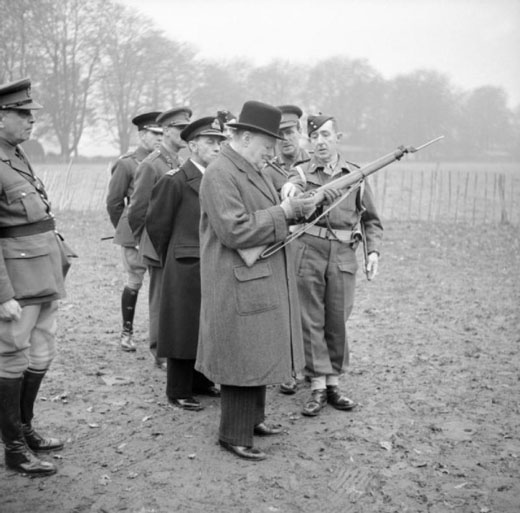 |
Guadalcanal Early in the day, the Japanese attack the left flank of the 1st Battalion, 182nd Infantry, and force it back, but the 1st Battalion recovers its lost ground with help from aircraft and artillery. It then drives forward until stopped by enemy fire just west of Point Cruz. The enemy retains its position at Point Cruz. Realizing more troops are needed west of the Matanikau, Gen Edmund Sebree orders the 164th Infantry out of reserve to fill the gap between the 2 battalions of the 182nd. The 164th Infantry moves forward during the night to bridge the gap between the assault battalions of the 182nd Infantry. The 1st Battalion, 164th Infantry, enters the line on the left of 1st Battalion, 182nd Infantry, and the 3rd Battalion, 164th, moves in between the 2nd Battalion, 182nd Infantry, and the 1st Battalion, 164th. Each battalion takes over about 500 yards of line and the battalions of the 182nd extend their flanks to join with those of 164th.
[  | |   ] ]
|
Hungary, Home Front Count Leopold von Berchtold, the notorious Austro-Hungarian Foreign Minister at the outbreak of World War I, dies at the age of 79.
[  | |   ] ]
Indian Ocean The US freighter Pierce Butler (7191t) is torpedoed and sunk by U-177 off the coast of South Africa. All on board, 41-man crew and 21-man Armed Guard, abandon the ship in 4 lifeboats. They are rescued the next day by the British destroyer Forward.
[  | |   ] ]
Mediterranean The siege of Malta ends. Operation STONE AGE successfully brings desperately needed supplies.
[  | |   ] ]
New Guinea Advance elements of the Australina 25th Brigade enter Gona, but are driven out after nightfall. The 126th Infantry, US 32nd Division, upon reaching Popondetta, is sent on to Soputa to assist the Australian 16th Brigade. The Australian 16th Brigade clears the enemy rear guard from Soputa and continues along the Sanananda track to its junction with the main trail to Cape Killerton, but is halted at the enemy's forward defense line. Warren Force continues to meet heavy fire, which pins donwn the 3rd Battalion of the 128th Infantry on the left. The 1st Battalion is halted after a 100-yard advance in the coastal area. Col Carrier's detachment (elements of the 1st Battalion, 126th Infantry) and the Australian 2/6th Independent Company arrive at the front and prepare to join in the attack along the coast. The Australian and American attacks on the Japanese positions continue intermittently for the next 10 days, but with small success.
[  | |   ] ]
North Africa
LIBYA
Rommel continues his withdrawal westward.
TUNISIA
Renewed German pressure forces the French XIX Corps, together with British and attached US forces, to retire from the area of Medjez el Bab some 10 miles west to Oued Zarga where forward elements of Blade Force, British 1st Army, are located. The main body of Blade Force is concentrated in the Souk el Arba area. The British 1st Parachute Battalion is holding Bédja.
[  | |   ] ]
Vichy, Politics Laval broadcasts once more in support of Germany. He says that Germany will win the war and that the alternative is to be ruled by 'Jews and Communists.' At a press conference on December 13th he confirms these views announcing 'I must say without any ambiguity, that I want Germany's victory.'
[  | |   ] ]
|
Saturday, November 21
Air Operations, Algeria For the second consecutive night, Luftwaffe bombers based in Sardinia attack the Algiers/Maison Blanche Airport, this time destoying 1 B-17 and damaging 16 other Allied aircraft on the ground. These attacks lead to an immediate upgrading of night-fighter and night anti-aircraft defenses.
[ | |  ] ]
Air Operations, Europe
BOMBER COMMAND
Evening Ops:
- 30 aircraft are sent to the Biscay ports to lay mines from Lorient to Bayonne. There are no losses.
US 8th AIR FORCE
BELGIUM:
A 4th Fighter Group Spitfire downs an Fi-156 observation plane near Furnes during a fighter sweep.
[  | |   ] ]
Air Operations, Far East RAF bombers hit the fuel dump on Mingaladon airfield, Burma.
[  | |   ] ]
Air Operations, New Guinea - In support of a US Army ground attack, V Bomber Command A-20s attack Sanananda and the airfield, bridge, and anti-aircraft emplacements at Buna with parachute-fragmentation bombs from no higher than 60 feet. B-25s mount follow-up attacks of the same targets from 6,000 feet. The results of the low-level attack are limited due to the lack of air-ground coordination.
- A rough advance airstrip is completed by US Army engineers and infantrymen at Dobodura, 15 miles from Buna. This site will grow to become a leading air base in Papua New Guinea, but for the moment it will be used for landing supplies and equipment and the evacuation of wounded.
[  | |   ] ]
Air Operations, North Africa B-17s and P-38s raid the Tunis Airport.
[  | |   ] ]
Air Operations, Tunisia - Making use for the first time of the staging facilities at Gambut Main, near Tobruk, Libya, 9 of 15 98th Heavy Bomb Group B-24s sent from their bases in Egypt complete their attacks on the harbor at Tripoli.
- Later in the day, 8 376th Heavy Bomb Group B-24s attack the harbor at Tripoli, also after staging through Gambut Main.
- The 14th Fighter Group's 48th Fighter Squadron, in P-38s, mounts a strafing attack against German Army units moving on the US Army garrison at Gafsa.
- 6 P-38s are lost as they attempt night landings at Youks-les-Bains Airdrome in Algeria.
[  | |  ] ]
|
Battle of the Atlantic - At 1100 an Albacore aircraft from HMS Victorious, on passage from Gibraltar to Greenock, sees U-517 diving and attacks immediately with depth charges. The U-boat is blown to the surface with extensive damage to the bridge and conning tower. The destroyer Opportune is notified and sent to the scene, but U-517 had been scuttled.
U-517|
| Class | Type IXC |
| CO |
Kapitänleutnant Paul Hartwig |
| Location |
Atlantic, WNW of Cape Finisterre |
| Cause |
Air attack |
| Casualties |
1 |
| Survivors |
51 |
- The US destroyer Somers (DD-381) intercepts the German blockade runner Anneliese Essberger in the South Atlantic. The German ship is scuttled by her crew.
[  | |   ] ]
Eastern Front Northwest of Kletskaya the Rumanian 3rd Army is in a desperate condition being pressed hard by the Russian 5th Tank Army. The Soviets have 34 divisions in the advance and have broken through on a 50-mile front. Tank units from Rokossovsky's Don Front, which opened the Serafimovich offensive, are advancing rapidly toward Kalach and Golubaya. The 64th Army carries out a turning movement and threatens to cut off the Germans in Stalingrad. The German command is disorganized. 6th Army's staff is being forced to move because of the Soviet advance and Gen von Manstein, who has been ordered to take command of a new Army Group Don, is making a long train journey to take up his post. Von Paulus proposes a retreat to the Don which Hitler rejects.
SOUTHERN SECTOR
Elements of the 5th Tank Army encounter the 24th Panzer Division near the Don bridges behind the 6th Army. Fighting at Businovka results in serious German casualties and a hasty withdrawal. Paulus' plans to shore up his left wing fall apart.
Heavy fighting continues at Raspopinskaya as Group Lascar fights off repeated Soviet attacks. The Soviet IV Tank Corps takes Golubinskaya as its advance into the German rear continues. Paulus and his headquarters staff have only just left town for Nizhne Chirskaya and evade capture by a matter of hours. By evening Gen Aleksandr Vasilevsky is able to report to Stalin that the IV and XXVI Tank and III Guards Cavalry Corps are all heading for Kalach.
The drive from the south accelerates as the IV Mechanized Corps reaches Zety. Inexplicably, Gen Vasily Volskii orders a hald so he can regroup but is promptly ordered to resume the advance. Elements of Gen Timofey Shapkin's IV Cavalry Corps, supporting Volskii, capture Abganerovo and cut the railway line to Kotelnikovo.
The collapse of his flanks prompt Paulus to request permission to abandon the Volga and pull back to the Don-Chir line. Army Group B agree with this proposal and issue orders for its implementation, pending approval by Hitler. This early chance to save the 6th Army is lost when Hitler orders the Volga line be held.
[  | |   ] ]
|
Guadalcanal The 1st Battalion, 182nd Infantry, attacks west from the Point Cruz area but meets heavy artillery and mortar fire as well as small arms fire from Japanese entrenched on Point Cruz. This battalion reduces Point Cruz, but does not advance westward. The battalions of the 164th also attack to the west from the Hill 80-81 ridge line. A series of steep ridges (Hills 83 and 82) lies to the west, but to gain the ridge 50 yards of open ground would have to be crossed. The Japanese, whose defenses are skillfully organized in depth and mutually supporting, have dug in well to cover that area and the 164th Infantry is quickly halted after gaining an average of less than 40 yards.
The Amercans are moving but slowly because of the terrain and stubborn Japanese resistance. Finding a large group of Japanese is a problem. They learn from the islanders there are about 3,000 troops at Rekata Bay on the northwest coast of Santa Isabal Island. They may be headed for Guadalcanal, but no one knows for sure. The marines suspect a new effort at supply of the Japanese on a piecemeal basis. The Japanese command is distressed that there are 10,000 troops on the island and no way to supply them. Several methods are tried: destroyers dropping off oil drums filled with medical supplies and rice and tied together; submarines surfacing at night to deliver to landing boats. These methods are just not enough for what is needed. By the end of the month all the rice and other staples will be gone. Foraging and eating wild plants is next with the sick list growing longer every day.
[  | |   ] ]
Indian Ocean The US freighter Alcoa Pathfinder (7200t) is torpedoed ans sunk by U-181 about 6 miles off the coast of Portuguese East Africa with the loss of 5 of her crew. The survivors row to shore.
[  | |   ] ]
New Guinea The Australian 16th Brigade, reinforced by the American 126th Infantry Regiment, makes slight and very costly progress towards Sanananda. The 2nd Battalion of the 128th Infantry, US 32nd Division, begins to drive on Buna Mission, moving from Ango along the Dobodura-Buna track when upon reaching the trail junction, called the Triangle, where the trails to Buna Missiona and Buna Village converge, is halted by well-organized bunker positions that are made more formidable by swampy terrain on both sides of the Triangle. Since no further progress can be made with forces present, the 2nd Battalion of the 126th Infantry is ordered to cross the Girua river and assist.
The attack of Warren Force is delayed by a series of mishaps, but gets under way by 1630 after an air and artillery preparation, which is of little benefit. Casualties are again heavy and the gains made are negligible. The 3rd Battalion, 128th Infantry, attempting to take the bridge between the airstrips, is pinned down by enemy fire. The Australian 2/6th Independent Company tries to secure the east end of the New Strip by infiltration and knocks out a few machine gun positions in the area. Along the coast, the 1st Battalion, 128th Infantry, and Col Carrier's detachment of the 1st Battalion, 126th Infantry, attack abreast, gaining a few yards and destroying some machine gun nests. The situation improves somewhat as additional guns are brought forward and the airstrip at Dobodura becomes operational.
[  | |   ] ]
North Africa
LIBYA
British and American aircraft carry out a heavy raid on the harbor at Tripoli.
TUNISIA
Elements of Hart Force succeed in rejoining the 36th Brigade, 78th Division, British 1st Army. The Germans withdraw to the east bank of the river at Medjez, but the 78th Division is too weak to follow up and is ordered to await reinforcements. The 2nd Battalion, 509th Parachute Infantry, withdraws from Gafsa to Fériana, about 40 miles north.
[  | |   ] ]
|
Images from November 21, 1942
|
|
SS Troops Ready to Attack
|
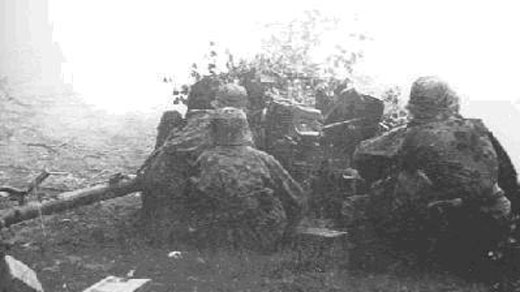 |
|
Soviet Attack around Stalingrad in Freezing Conditions
|
 |
|
|
Sunday, November 22
Air Operations, Bismarcks V Bomber Command B-17s and B-25s attack shipping from Arawe to the northern Solomon Islands.
[  | |   ] ]
Air Operations, CBI In their unit's first combat mission since switching from B-17s, 6 B-24s of the 7th Heavy Bomb Group's 9th Heavy Bomb Squadron attack the marshaling yards at Mandalay, Burma.
[  | |   ] ]
Air Operations, Europe
BOMBER COMMAND
Evening Ops:
- 222 aircraft are sent to Stuttgart: 97 Lancasters, 59 Wellingtons, 39 Halifaxes and 27 Stirlings.
- A thin layer of clouds and some ground haze prevent the Pathfinders from marking the city center; the bomb loads are dropped to the southwest and south of the center and in the residential districts of Vaihingen, Rohr, Mohringen and Plieningen which are all about 5 miles from the city center; 88 houses are destroyed and 334 seriously damaged; 28 people are killed and 71 injured.
- 5 Lancasters, 3 Wellingtons and 2 Halifaxes are lost.
Minor Ops:
- 1 OTU makes a leaflet flight over France and returns safely.
US 8th AIR FORCE
FRANCE:
Although 76 VIII Bomber Command heavy bombers are sent against the Lorient U-boat base, only 11 303rd Heavy Bomb Group B-17s find a hole in the clouds and drop their bombs. The 305th Heavy Bomb Group, in B-17s, makes its combat debut but drops no bombs.
[  | |   ] ]
|
Air Operations, New Guinea - 22nd Medium Bomb Group B-26s attack targets around Buna, B-17s and B-25s attacl the airfield at Lae and landing barges between Lae and Salamaua, and A-20s attack trails in the Sanananda area.
- 35th Fighter Group P-400s down 3 A6M Zeros over Buna at 1105 hours, and 49th Fighter Group P-40s down 2 Zeros near Buna between 1720 and 1740 hours.
[  | |   ] ]
Britain, Home Front Sir Stafford Cripps becomes Minister of Aircraft Production.
[  | |   ] ]
Eastern Front The two branches of the Soviet pincer close at Kalach, trapping the German 6th Army and part of the 4th Panzer Army along with some smaller formations. Included in the encirclement are 250,000 men, 100 tanks, 1,800 guns and over 10,000 vehicles.
SOUTHERN SECTOR
Advancing rapidly, Gen Alexey Rodin's XXVI Tank Corps closes upon Kalach. The lead tanks audaciously gain control of the bridge over the Don, but an attack upon the town is repulsed by elements of the 71st Infantry Division. Later in the day the main body of the XXVI Tank Corps captures Kalach after the IV Tank Corps has moved up to provide support. The 24th Army launches new attacks against the XI Corps, aiming to isolate the Germans between itself and the 65th Army. Gen Vasily Volskii's IV Mechanized Corps takes Sovetski as it pushes up from the southeast.
The 6th Army is in imminent danger of isolation in Stalingrad. Paulus, having only just moved his headquarters to Nizhne Chirskaya, is ordered back to Gumrak. Hitler is suspicous that Paulus will order a retreat from the Volga on his own initiative. Paulus believes that the only viable course of action is the abandonment of Stalingrad and, informing Army Group B, stresses the urgent need for supplies. Gen Maximilian von Weichs forwards the request, and an assessment of the situation, to Hitler, who does not respond until after hsi journey from Berchtesgaden to Rastenburg.
|
Hoth's 4th Panzer Army is under heavy attack following the collapse of the 4th Rumanian Army. Left with the few Rumanian soldiers fleeing before the 57th and 51st Armies and the IV Corps, Hoth's army rapidly breaks apart. The IV Corps has become separated, being forced away from the retreating Rumanians. As the pocket is slammed shut on the 6th Army the IV Corps is handed over to Paulus.
[  | |   ] ]
Guadalcanal The 182nd and 164th Regiments again meet strong resistance while attempting to push west and are unable to advance. The 8th Marines prepares to attack through the 164th Infantry.
[  | |   ] ]
New Guinea While the Australian 25th Brigade pushes on in the direction of Gona, the US 126th Regiment attacks in the Sanananda sector. Maj Boerem's detachment (elements of the 1st Battalion) moves along the road as the 3rd Battalion. on its flanks, moves along secondary trails. After nightfall, fresh Japanese forces attack Company L, flanking on the right, to insure the safety of their food supply dump which is the line of advance, but are driven off. From Soputa, the 2nd Battalion of the 126th Infantry moves forward to assist the 2nd Battalion of the 128th, crossing to the east bank of Girua River on rafts during the evening.
On the Warren Force front, the 3rd Battalion of the 128th Infantry secretly pulls back to positions just behind the 1st Battalion, though Company I holds the former position astride the trail just west of New Strip.
[  | |   ] ]
North Africa
LIBYA
Thrusts by strong British columns in the Agedabia area, in Libya, are temporarily checked by the Germans.
TUNISIA
The 36th Brigade, 78th Division, British 1st Army, repels an attack at Djebel Abiod. The 11th Brigade of the 78th Division completes its concentration at Bédja. French and US troops occupy Gafsa.
[  | |   ] ]
|
Images from November 22, 1942
|
|
German Artillery Continues to Bombard Leningrad
|
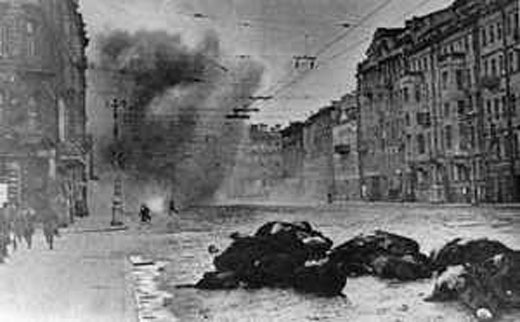 |
|
Searching for Mines along the Desert Railway
|
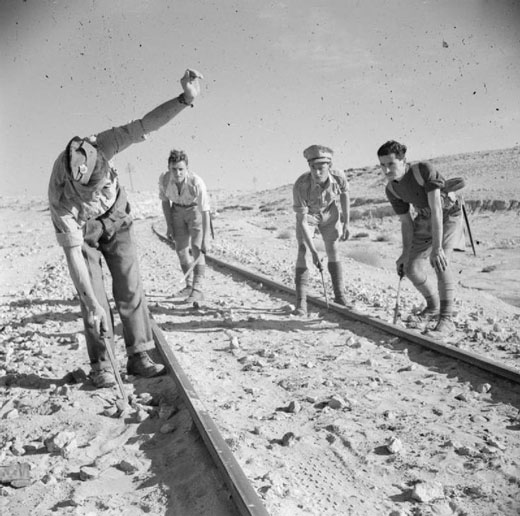 |
|
|
Monday, November 23
Air Operations, CBI - 6 11th Medium Bomb Squadron B-25s and 17 23rd Fighter Squadron P-40s attack the Tienho airfield at Canton, China and claim the destruction of more than 40 Japanese aircraft on the ground. 23rd Fighter Group P-40s shoot down 3 Japanese bombers over Kweilin, China between 0130 and 0210 hours.
- After feinting toward Hong Kong, 9 11th Medium Bomb Group B-25s and 7 23rd Fighter Squadron P-40s attack shipping in the Gulf of Tonkin near Haiphong, French Indochina claiming 1 freighter sunk and 2 damaged.
[  | |   ] ]
Air Operations, Europe
BOMBER COMMAND
Evening Ops:
- 35 aircraft are sent to the Biscay ports and the Frisians to lay mines. There are no losses.
US 8th AIR FORCE
FRANCE:
- 36 of 58 VIII Bomber Command B-17s and B-24s attack the St.-Nazaire U-boat base with nearly 79 tons of bombs. Claims against enemy aircraft amount to 16 destroyed and 2 probables.
- 4 B-17s are missing, 16 B-17s and 1 B-24 damaged; 3 crewmen killed, 16 wounded, and 43 missing
[  | |   ] ]
Air Operations, Far East - American aircraft dive-bomb the bridge at Hankow and the airfield at Canton. RAF Wellingtons bomb Meiktila airfield, Burma, starting large fires.
- There is a Japanese night raid on Kweilin, a US air base in southwest China.
[  | |   ] ]
Air Operations, New Guinea 22nd Medium Bomb Group B-26s and 3rd Light Bomb Group A-20s attack the area around Sanananda.
[  | |   ] ]
Air Operations, Solomons 6 Cactus Air Force SBDs attack a new Japanese base at Munda, New Georgia.
[  | |   ] ]
Battle of the Atlantic The US tanker Caddo (19,172t), en route from Baytown, Texas to Iceland, is torpedoed and sunk by U-518 and abandoned with the 42-man crew and 17-man Armed Guard taking to lifeboates. The ship's master and another officer are taken prisoner. Only 6 of those taking to lifeboats are ever rescued and those are picked up by the Spanish motorship Motomar on December 8.
[  | |   ] ]
Eastern Front The important bridge over the Don at Kalach is captured by Soviet forces coming from the north in a surprise attack. After crossing this bridge advance units link up with tank forces of 51st Army and the encirclement of Stalingrad begins. The Soviets believe that they have about 85,000 Germans cut off in the city when in fact the total is nearer 300,000. Being surrounded by the Soviet 5th Tank Army and the 21st Army, 5 Rumanian divisions of the Rumanian 3rd Army's total of 7 surrender around Raspopinskaya, south of Serafimovich.
|
The Soviets intend, as their first priority, methodically to destroy the Stalingrad garrison before continuing their offensive to the west. Zhukov supports this unambitious scheme because he is well aware of the limitations of the Soviet forces in wide-ranging operations. Despite this priority, the false assessment of German positions leaves the siege forces short.
The Germans trapped at Stalingrad are attacked in the rear by the Soviet 65th and 64th Armies. The commander of Army Group B, Gen Maximilian von Weichs, urges von Paulus, 6th Army commander, to break out of the encirclement before the Russians can bring up new forces around the besieged city. Hitler, however, has assumed personal command of the army. When Field Marshal Göring assures him that the Luftwaffe will be able to get supplies, ammunition and material into Stalingrad at a rate of 700 tons per day, he orders von Paulus to hold out where he is, in the expectation that Army Group B will resume the offensive to relieve him.
Hitler goes on to order the setting up of 'Fortress Stalingrad', and insists that not a yard of ground shall be given up. Meanwhile Field Marshal von Manstein is recalled from the Leningrad front and assumes command of the Don Army Group, consisting of the 4th Panzer Army, part of the 6th Army and several armored and mechanized groups. He is given the task of relieving Stalingrad and restoring the original front.
Manstein organizes his forces in two big operational groups, the Hoth Group south of the Don and Hollidt (Gen Karl-Adolf) Group north of it. The plan, largely dictated by Hitler, is to attack Gen Yeremenko's Stalingrad Front group, then, unexpectedly, to withdraw to attack Rokossovsky's Don Front in concert with von Paulus' army, which will by then have broken through the Soviet ring round Stalingrad.
The Russians are faced with a very important decision on strategy: whether they should concentrate their forces from the southern front on liquidating the German troops trapped at Stalingrad, or whether they should isolate Stalingrad and launch a massive attack to cut off the German forces falling back from the Caucasus.
The first alternative prevails: the immediate liquidation of the Germans left in Stalingrad because the Russians are convinced that the elimination of von Paulus' 6th Army will only require a few days. The German forces are tightly encircled and a further 'external' ring, with a circumference of about 285 miles, is thrown around the city to resist any attempt of the besieged forces to break out. This decision, which, in fact, permits the Germans to withdraw their forces from the Caucasus, is based on an almost incredible error in estimating the strength of the beleaguered German army. The Russians surround Stalingrad with a relatively small force of 480,000 men, thinking that there are approximately 90,000 Germans in Stalingrad. It is not until January 26th that the Russians realize that 330,000 German soldiers are trapped in the city. German sources say 284,000.
In the Siege of Leningrad German heavy artillery and bombers are in action before dawn. 50,000 shells hit the city during 1942. Shelling takes place on 254 days.
SOUTHERN SECTOR
Some 27,000 Rumanian soldiers surrender, signalling the end of their 3rd Army, which has lost 90,000 casualties since the start of URANUS. Red Army units link up at Kalach, thus trapping the German 6th, part of the 4th Panzer and what is left of the Rumanian 4th Armies 256,000 German troops, 22,000 Rumanians, 100 tanks, 1,800 artillery pieces, 10,000 motor vehicles and 23,000 horses.
Gen Paulus put his forces into a giant hedgehog defensive posture as part of the grandly titles 'Fortress Stalingrad'. However, he has serious problems. First, establishing an effective defensive perimeter at Stalingrad is difficult due to a desperate shortage of infantry and the lack of prepared positions. Second, to the south and west lay almost completely treeless, shelter-free steppes. Third, a lack of fuel, which prevents the rapid deployment of his three panzer and three panzergrenadier divisions as mobile reserves. Fourth, a general shortage of artillery ammunition also weakens the German defense.[MORE]
[  | |   ] ]
|
France, Politics Darlan announces that French West Africa now accepts his authority.
[  | |   ] ]
Guadalcanal After the 245th Field Artillery Battalion and L Battery and the 1st and 2nd Battalions, 11th Marines, fire a 30-minute concentration on the Japanese lines,, the 8th Marines passes through the 164th Infantry to continue the attack westward but is unable to advance. The marines deliver successive attacks throughout the day. The Japanese defend vigorously putting fire all along the entire American line. The Americans fail to gain any ground. The American headquarters concludes further attacks would be fruitless with the resources at hand. The troops are ordered to dig in and hold the Hill 66-80-81-Point Cruz line to await reinforcements.
By this time, 84 US and New Zealand planes are operating from Guadalcanal.
[  | |   ] ]
New Guinea The main body of the Australian 25th Brigade arrives at the front and begins the assault on Gona against determined resistance. The 3rd Battalion of the 126th Infantry, US 32nd Division, continues toward Sanananda. Company L, on the right, is pinned down by enemy fire at the edge of the food dump.
The airfield at Popondetta becomes operational, and 4 guns are flown in and emplaced just south of Soputa. The 2nd Battalions of both the 126th and 128th Regiments are combined to form Urbana Force under the command of the CO, 128th Infantry. The 2nd Battalion of the 128th Infantry is slowed by extremely difficult terrain as it advances against the Triangle along the main track with swamps on either side of it.
Warren Force commander, Gen MacNider, is wounded while inspecting the front and is replaced by Col J. Tracy Hale, Jr. After an ineffective preparatory fire against enemy bunkers, the 1st Battalion of the 128th Infantry and Col Carrier's detachment of the 1st Battalion, 126th Infantry, attack along the coast toward Cape Endaiadere, gaining some 300 yards against intense fire. The Australian 2/6th Independent Company makes limited progress toward the east end of New Strip.
[  | |   ] ]
North Africa
ALGERIA
The Allied general headquarters is transferred from Gibraltar to Algiers.
LIBYA
The retreating Axis forces, taken in flank by the 7th Armored Division of the British X Corps, around Agedabia the Axis troops fall back to the El Agheila position where Rommel hopes he can hold up the enemy advance. Montgomery halts his advance to reorganize his forces, which have now chased their enemy almost 600 miles in 14 days. The British advance has been perhaps too cautious although German demolitions and booby traps have been one cause of delay.
TUNISIA
British and French commands determine their respective spheres of command: all troops north of a line from Le Kef to Zaghouan will be under British command, those south of the line under French command.
[  | |   ] ]
United States, Home Front The US Coast Guard accepts women into service under the title SPARS (Semper Paratus Always Ready). Capt Dorothy Stratton is the commander.
[  | |   ] ]
West Africa In Senegal, Dakar, a vital base in French West Africa, is occupied by the Allies without bloodshed following a decision by Governor-General Pierre Boisson to abandon his former allegiance to Vichy.
[  ] ]
|
Images from November 23, 1942
In the Trenches at Stalingrad
|
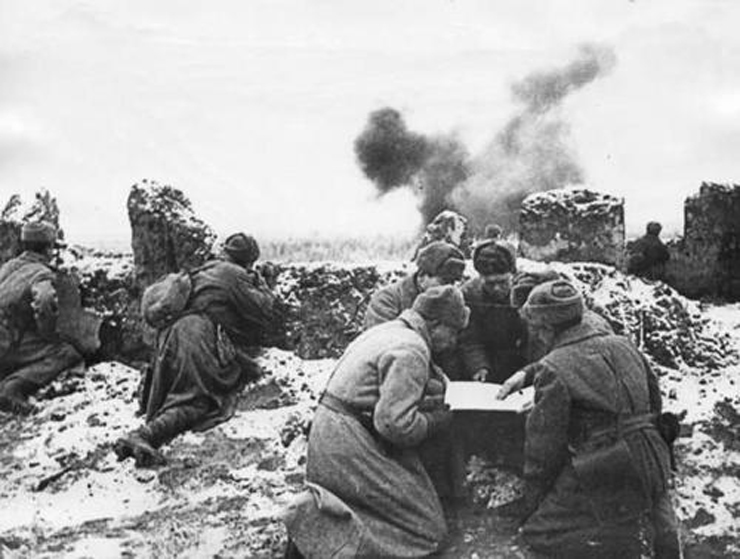 |
|
Luftwaffe Begins Supplying 6th Army
|
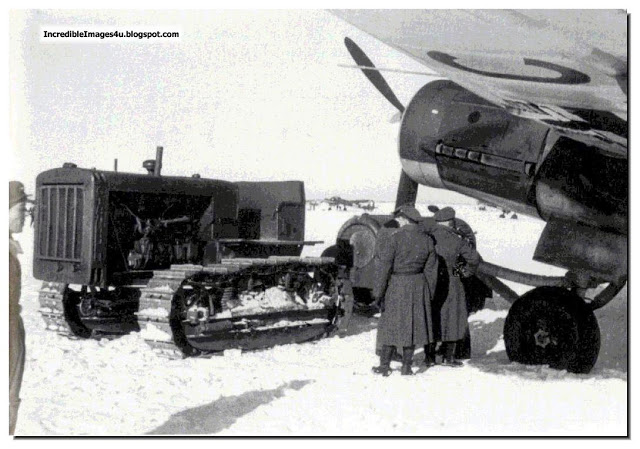 |
|
Natives Carrying the Wounded
|
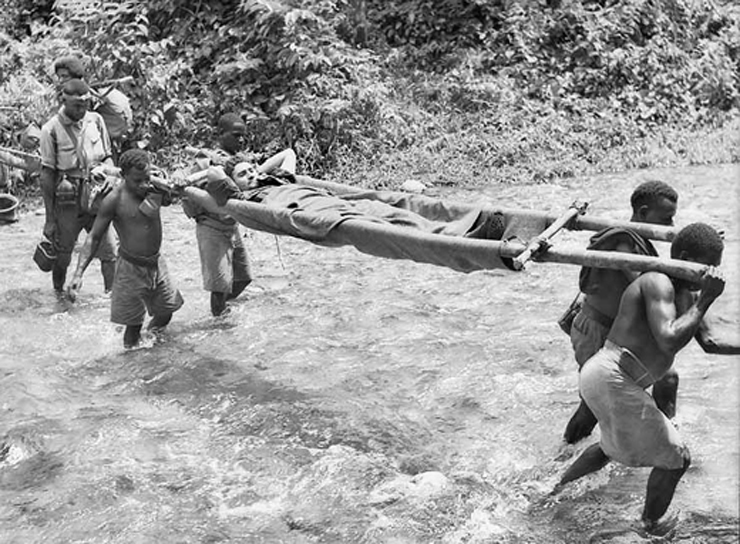 |
|
Captured Japanese Equipment
|
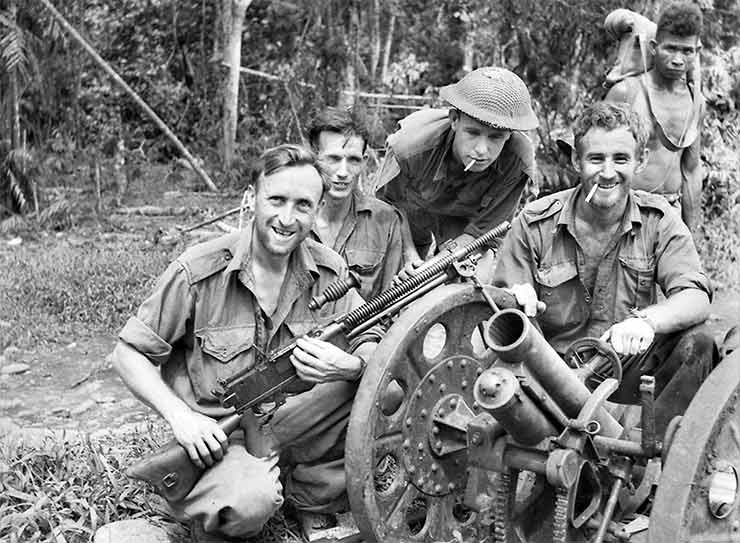 |
|
An American M3 and Crew
|
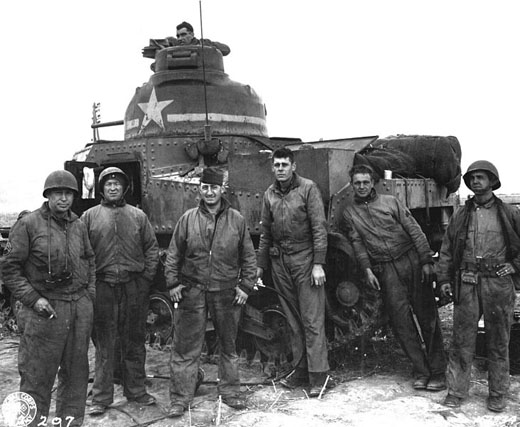 |
|
Tuesday, November 24
Air Operations, CBI 23rd Fighter Group P-40s down 2 Ki-27 'Nate' fighters near Canton, China.
[  | |   ] ]
Air Operations, New Guinea - In an all-out effort in support of US and Australian army ground offensives, V Bomber Command B-17s, B-25s, B-26s, and A-20s, and V Fighter Command P-39s, P-40s, and P-400s attack targets in and around Buna and Sanananda.
- During the night, 7 V Bomber Command B-17s mount low-level attacks against a Japanese light cruiser and as many as 5 destroyers encountered in Huon Gulf between Lae and Finschhafen.
[  | |   ] ]
Air Operations, North Africa The RAF raids airfields at Gabes, Bizerta and Tunis.
[  | |   ] ]
Air Operations, Solomons 4 11th Heavy Bomb Group B-17s attack Munda, New Georgia.
[  | |   ] ]
Air Operations, Tunisia In the course of two fighter engagements, 14th Fighter Group P-38s down 11 Axis aircraft, including 9 Italian Air Force transports downed between Gabes and Sfax at 1355 hours.
[  | |   ] ]
Allied Planning Gen Stilwell is informed by the US War Department that the United States will not be able to supply men and materials, over and above those they are already supplying, for the projected offensive for the recapture of Burma.
[  | |   ] ]
|
Solomons The Japanese land special units at Munda in New Georgia, west of Guadalcanal, where they intend to construct airfields. Even though the American navy is patrolling closely the Japanese manage to bring supplies to Guadalcanal by sea. Fast destroyers operating at night drop floating drums tied together with cord, near the coast, and the infantry picks them up in boats or by swimming.
[  | |   ] ]
Eastern Front Manstein arrives at Army Group A Hq. He has been summoned south from Leningrad to restore the situation but the forces allocated to him to create Army Group Don are either practically nonexistent or shut in Stalingrad. The whole of 6th Army and most of 4th Panzer Army are surrounded, and have orders from Hitler to maintain their positions with the help of air supply. Five of seven divisions of the 3rd Rumanian Army have surrendered. Almost the only significant German unit available to Manstein is a division holding the important position at Elista which ought to be maintained as a link with Army Group A in the Caucasus. The other German Army Group commanders and the High Command cooperate with Manstein's request for reserves only with reluctance and his buildup is, therefore, slow.
It is not at all clear to Manstein how he should proceed even when his forces are assembled. The Soviets already have over 1,000 anti-tank guns in positions around Stalingrad and with such opposition a breakout may be impossible. Even if a breakout is possible Manstein cannot be sure that it is desirable. Since the Soviets would have no need to continue to invest the city they could devote their forces to further wide encirclements, to which the Germans could be especially vulnerable with 6th Army and the relieving force concentrated at the tip of an exposed salient. In this situation the whole of Manstein's forces and also Army Group A in the Caucasus might well be endangered. In fact this large threat will not materialize for the moment because of the more limited Soviet intentions, but it must remain in Manstein's thoughts.
Hitler's orders to hold on to Stalingrad are based on a wild claim by Göring that Stalingrad can be supplied by air. 6th Army would need at least 700 tons of supplies each day and for this 500 planes would be necessary as well as good weather and low losses. There are 300 planes available and their airfields are in poor condition and under threat from the Soviet advance. There is no possibility of Göering keeping his promise although the attempt will be made and almost 500 planes lost before the end of the siege. They will manage to take ou 42,000 wounded men and some important specialists.
The German High Command admits that the Red Army has 'broken into our defensive front on the Don'. In the central sector, west of Moscow, there are Soviet attacks around Rzhev and Velikiye Luki.
|
CENTRAL SECTOR
The eve of Operation MARS, Zhukov's plan to destroy enemy forces alont the Moscow axis in the Rzhev salient (the German 9th Army). This will be no easy task, as Gen Model's 9th Army has build strong defenses around the salient and fortified all cities and towsn along the salient's edges, especially the key cities of Rzhev, Belyi and Sychevka.
SOUTHERN USSR
Luftwaffe chief Hermann Göring assures Hitler that his aircraft can supply the Stalingrad Pocket. Zeitzler does not believe this boast. Wolfram von Richtofen, commander of the 4th Air Fleet, believes it will be impossible to supply the 6th Army. He has just 298 transport aircraft for the task of landing 350 tons of supplies a day (he needs at least 500 transports.[MORE]
[  | |   ] ]
New Guinea The Japanese continue to repel the efforts of the Australian 25th Brigade to take Gona. The 3rd Battalon of the 126th Infantry, US 32nd Division, pushes on toward Sanananda. 2 Australian companies join Company L in the battle for the food dump on the right. On the left, Companies I and K reach a clearing west of the Killerton trail, some 1,200 yards north of the original starting point, but are driven back into the swamp by enemy infiltrators.
Urbana Force launches a coordinated assault on the Triangle at 1428 after an ineffective air and brief mortar preparation. While Company F of the 126th Infantry makes a frontal assault in which Company H of the 128th joins, Company E of the 126th takes over the left flank positions along Entrance Creek and Companies E and G of the 128th attack on the right flank. The attack, although carefully planned, is a failure.
Warren Force front along the coast is quiet.
[  | |   ] ]
North Africa
LIBYA
Rommel has reached El Agheila, All he has left is 35 tanks and the tattered remnants of 2 divisions. Yet Montgomery, now at Agedabia, less that 62 miles away, takes time (more than 3 weeks) to reorganize the 8th Army and resume the offensive. By December 13th, when the decision to attack finally comes, Rommel will already have slipped away brilliantly. Even the 8th Army GHQ admits 'The enemy has escaped with a clever withdrawal.'
TUNISIA
The British 1sh Army is ordered to advance on Tunis, with Tebourba and Mateur as their first objectives. The main body of Combat Command B, US 1st Armored Division, begins the move from Tafaraoui, Algeria, to Tunisia. The 1st Battalion of the 1st Armored Regimentt arrives at Bédja and is attached to Blade Force.
[  | |   ] ]
|
Images from November 24, 1942
|
|
Stuka Raid in the Factory District
|
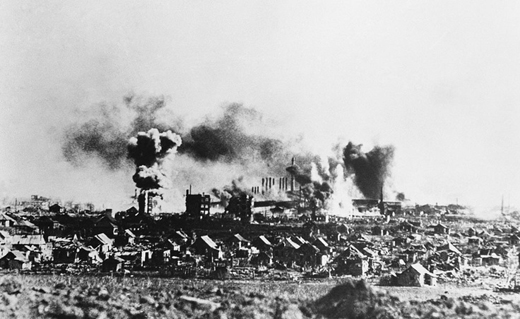 |
|
Russian T-34 and German Sd.Kfz. 252
|
 |
|
|
Wednesday, November 25
Air Operations, CBI
CHINA
- 6 11th Medium Bomb Group B-25s damage 3 freighters on the Pearl River near Canton.
[  | |   ] ]
Air Operations, Europe
BOMBER COMMAND
Daylight Ops:
- 6 Wellingtons and 5 Lancasters are sent on cloud-cover raids to Essen and 5 smaller German targets, but most turn back because of a lack of clouds.
- 1 Wellington bombs ships off the Dutch coast.
- 1 Lancaster and 1 Wellington are lost.
Evening Ops:
- 22 Wellingtons and Halifaxes lay mines off St Nazaire and in the Frisians without a loss.
[  | |   ] ]
Air Operations, New Guinea A V Bomber Command B-25, operating alone, scores a direct hit on a Japanese cruiser at sea, and P-38s from the 35th Fighter Groupís 39th Fighter Squadron attack the airfield at Lae. A 39th Fighter Squadron P-38 downs an A6M Zero over Lae at 1020 hours, the first P-38 victory in the SWPA.
[  | |   ] ]
Eastern Front The Stalingrad Airlift begins. It will continue until February 2, 1943. Luftwaffe transport units, along with some bomber units from November 30, attempt to fulfill Göring's verbal promise to Hitler that the encircled 6th Army can be entirely supplied by air. The total number of planes involved rises from 320 in November to 500 in early December and 850 in late December. The deliveries promised were 500 tons per day; the actual daily average was 100 tons. The Luftwaffe loses 489 aircraft in the operation including 266 Ju-52s and 165 He-111s.
CENTRAL SECTOR
Operation MARS begins as the Soviet 20th, 31st, 39th, 22nd, 41st and 3rd Shock Armies smash into German positions. The Soviets make gains at Molodi tud, Belyi and Velikiye Luki.
SOUTHERN SECTOR
The Soviets have consolidated an inner ring around the German pocket at Stalingrad, consisting of the 21st, 24th, 57th, 62nd, 64th, 65th and 66th Armies - 490,000 troops.
|
Göring Promises to Supply Stalingrad
|
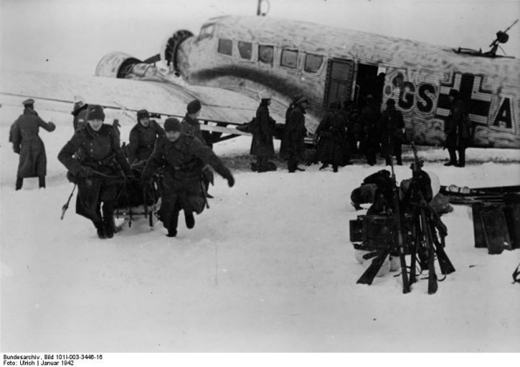 |
[  | |   ] ]
Greece, Resistance Led by British SOE agents, resistance workers from two rival Greek organizations join forces to blow up an important viaduct on the Athens-Salonika railroad at Gorgopotamos. Many of Rommel's supplies have in the past used this route.
[ ] ]
Guadalcanal By this date less than 2,000 men of the 164th Infantry are fit for combat. During the last week 117 men have been killed and 208 wounded. 325 are evacuated because of wounds or illness and another 300, have been rendered ineffective by wounds or illness, are kept in rear areas. The 1st Marine Division is soon to be relieved and pending departure leaves American troop strength less than that needed to execute any flanking movements over the hills south of Hill 66. Until reinforcements arrive offensive operations will have to be suspended.
An American destroyer surprises and shells a group of 40 Japanese motorized lighters at Tassafaronga. Enemy movements are reported on the islands of New Georgia and Santa Isabel.
[  | |   ] ]
New Guinea Firm Japanese opposition along the entire front has resulted in a virtual stalemate. Artillery fire is exchanged and patrols are active in some sectors.
[  | |   ] ]
|
North Africa
TUNISIA
The 36th Brigade, 78th Division of the British 1st Army, advances north of Djebel Abiod in the direction of Mateur. In the center, Blade Force penetrates the Axis positions between Mateur and Tebourba. Elements of Combat Command B, 1st Armored Division, carries out a raid on the airport at Djedeïda 5 miles east of Tebourba, destroying 30 enemy aircraft on the ground. The 11th Brigade of the British 78th Division retakes Medjez el Bab.
First Allied drive on Tunis
|
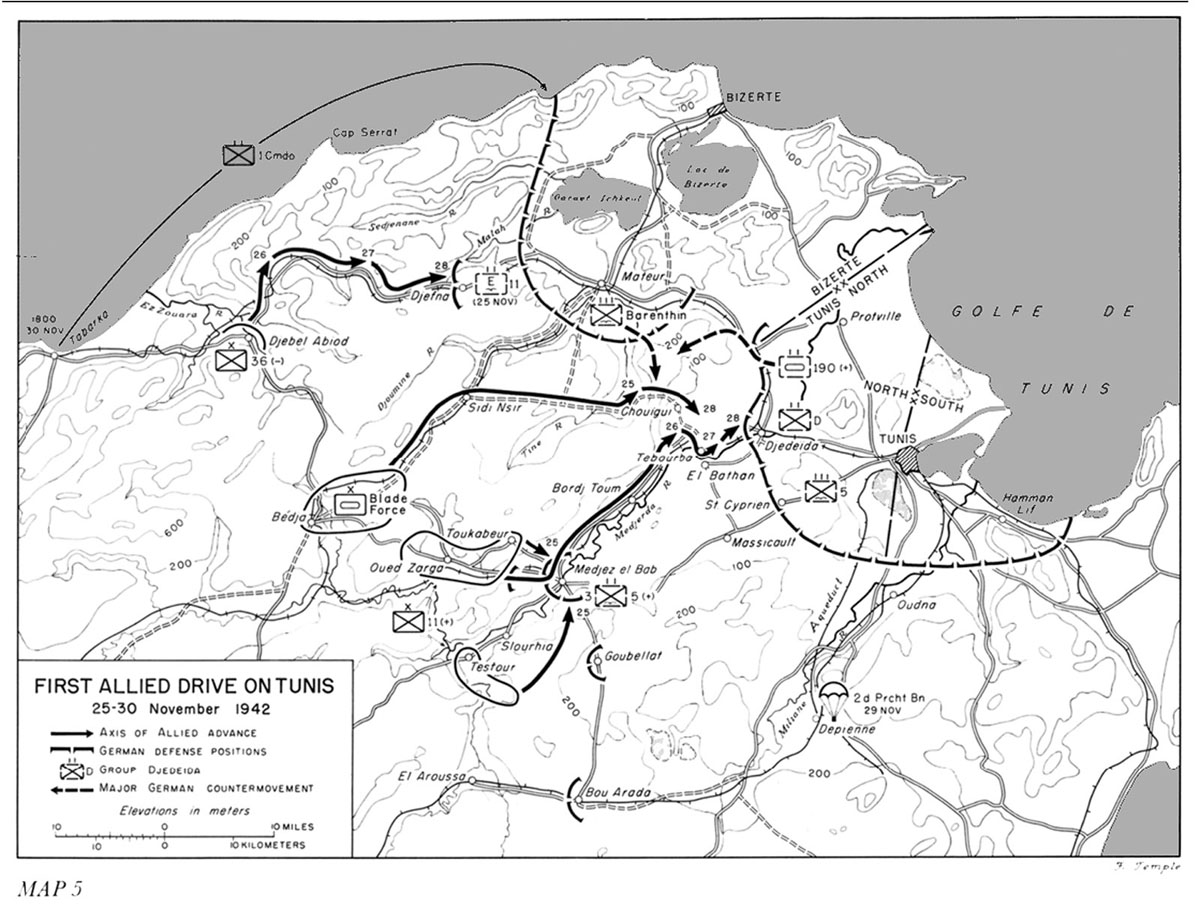 |
[  | |   ] ]
|
Thursday, November 26
Air Operations, Aleutians 4 28th Composite Bomb Group B-26s and 4 XI Fighter Command P-38s attack shipping targets at Kiska. 1 freighter is damaged as are 1 B-26 and 2 P-38s.
[  | |   ] ]
Air Operations, Europe
BOMBER COMMAND
Evening Ops:
- 30 aircraft lay mines off Lorient and St Nazaire, in the Frisians and the Kattegat without a loss.
[  | |   ] ]
Air Operations, Far East US bombers attack an oil refinery in Bangkok.
[  | |   ] ]
Air Operations, Libya IX Bomber Command B-24s conduct three separate attacks on Tripoli and claim direct hits on 3 Axis vessels.
[  | |   ] ]
Air Operations, New Guinea V Bomber Command B-25s, 3d Light Bomb Group A-20s, and 49th Fighter Group P-40s attack airfields and anti-aircraft positions in support range of Buna. 22d Medium Bomb Group B-26s attack various targets around Salamaua. 49th Fighter Group P-40s down 3 A6M Zeros near Buna at 1010 hours.
[  | |   ] ]
Air Operations, Solomons During the night 7 AirSoPac B-17s attack the Kahili airfield on Bougainville.
[  | |   ] ]
|
Air Operations, Tunisia 14th Fighter Group P-38s down 7 Luftwaffe aircraft, including 5 Ju-52 transports, during two separate actions.
[  | |   ] ]
Eastern Front The Soviets claim to have taken Krasnoye, Generalov and Selo on the Don. For the next few days there is something of a lull on the outer ring around Stalingrad. The Soviets are concentrating on the German pocket inside and the Germans are busy assembling strength for a counterattack.
CENTRAL SECTOR
After heavy fighting the 3rd Shock Army succeeds in isolating elements of the LIX Corps in Velikiye Luki. Other units of the corps are thrown back upon Novosokolniki.
The 20th Army renews its attack from the Vazuza bridgehead, but is in turn attacked by elements of the 5th Panzer Division. The Soviets move up their armor and repel the German attack. During the afternoon the VI Tank Corps enters the battle, pushing forward into the German positions but suffering heavy losses. Pushing toward the Rzhev-Sychevka road the Soviets are struck by the Germans during the evening, elements of the 9th Panzer Division dealing with the penetration.
The 39th Army continues to push south from Molodi Tud but is meeting strong resistance as the Germans reinforce the line with elements of the Grossdeutschland and 14th Motorized Divisions. The 22nd Army renews its attack, slowly forcing the Germans back but at a high cost. Counterattacks by other elements of Grossdeutschland bring the advance to a halt.
The 41st Army exploits its previous gains by pushing deeper into the German positions. The Germans erect strong defenses against the shoulders of the breakthrough, preventing the broadening of the attack. Lead Soviet units push ten miles into the German positions but suffer heavy losses. Behind the line 1st Panzer Division marches west in an effort to contain the break in the line, while elements of the XXX Corps are ordered up to fill the hole.
|
SOUTHERN SECTOR
Manstein arrives in the Don sector, assuming command of the newly formed Army Group Don. Included in his command are the 4th Panzer Army, 6th Army, 3rd and 4th Rumanian Armies. However, the 4th Panzer Army is an army in name only, consisting of the 16th Motorized Divisoin at Elitsa and the 18th Rumanian Division to its north. The 4th Rumanian Army, reduced to stragglers roaming the steppe around Kotelnikovo, can not be counted on. Despite this Manstein begins the formation of screening forces before Kotelnikovo. The 4th Panzer assumes control of the scattered Rumanian units, taking under its command the headquarters of the VI and VII Rumanian Corps.
Paulus' 6th Army, albeit under Army Group Don command, will effectively act only under Hitler's orders. Along the Chir Group Hollidt (Gen Karl-Adolf) assume control of three infantry divisions, all understrength. Hollidt also receives two new Luftwaffe field divisions and takes control over Gen Otto von Knobelsdorf's XLVIII Panzer Corps fighting in the Nizhne Chirskaya bridgehead. This unit has two panzer divisions, the depleted 22nd and Gen Hermann Balck's recently arrived 11th.
[  | |   ] ]
New Guinea At Gona the Australians and Japanese face each other without either side taking the initiative. The American 32nd Division tries again to capture Sanananda by frontal and flanking attacks, but without success, gaining only a few hundred yards. The Allies get to within 700 yards of the Killerton track and capture a supply depot, stubbornly defended by the Japanese. A powerful attack prefaced by a long air and artillery bombardment is launched on the west of the 'Triangle', where the Japanese defenses are least strong. The enemy shelters in bunkers during the bombardment and emerges to repel the attack with no great difficulty. The 127th Infantry Regiment of the 32nd Division reaches Port Moresby from Australia.
Despite losing a destroyer to air attack the Japanese manage to reinforce their troops at Buna.
[  | |   ] ]
North Africa
TUNISIA
The British 1st Army continues to advance. Blade Force fights its first armored battle on the plain south of Mateur.
[  | |   ] ]
|
Images from November 26, 1942
|
|
Russians Watching the Germans
|
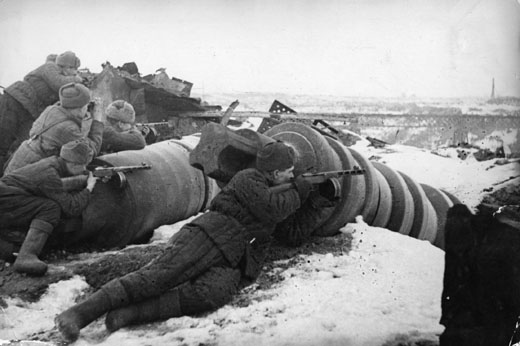 |
|
'Casablanca' Opens in New York
|
 |
|
|
Friday, November 27
Air Operations, CBI
CHINA
Using an attack by 10 Kweilin-based 11th Medium Bomb Squadron B-25s against the Hong Kong port to goad Japanese fighters aloft, 21 23d Fighter Group P-40 escortS down 23 Japanese fighters in a swirling engagement over Canton at about 1030 hours. No US aircraft are lost, although two damaged P-40s are forced to make emergency landings short of the airfield at Kweilin. Also, the B-25s are credited with sinking two small freighters.
[  | |   ] ]
Air Operations, Europe
BOMBER COMMAND
Daylight Ops:
- 6 Bostons are sent in low-level pairs to Belgium and Holland; 3 bomb various targets.
Evening Ops:
- 32 Lancasters and Stirlings are sent to Stettin.
- The raid is recalled and the planes drop their bombs in the North Sea.
- 10 aircraft are sent to lay mines in the Gironde River and off Texel, Gdynia and Danzig; the more distant locations are not reached.
[  | |   ] ]
Air Operations, Far East US B-25s and P-40s hit the docks and shipping at Canton and rout the defending Japanese fighters.
[  | |   ] ]
Air Operations, Greece 376th Heavy Bomb Group B-17s attacking the harbor at Portolago Bay, Leros Island, claim hits on 2 Axis vessels.
[  | |   ] ]
|
Air Operations, New Guinea 22nd Medium Bomb Group B-26s attack targets throughout the Buna area.
[  | |   ] ]
Air Operations, North Africa There is a heavy RAF raid on Tripoli.
[  | |   ] ]
Battle of the Atlantic The US freighter Jeremiah Wadsworth is torpedoed and sunk by U-178 about 270 miles south of Cape Agulhas, South Africa with no casualties. 43-crewmen and 14-man Armed Guard will be picked up December 5 and 6.
[  | |   ] ]
Eastern Front
CENTRAL SECTOR
The VI Tank Corps is unable to advance farther due to difficulties supplying its units. German counterattacks threaten to sever the corps' communications as the Soviets attempt to push their infantry through to support. Fierce battles rage as the 39th and 22nd Armies attempt to force their way forward. Ferocious fighting results in heavy casualties to both sides. Heavy fighting around Belyi continue as the 41st Army attacks. There is also very heavy fighting around Velikiye Luki as the 3rd Shock Army attempt to destroy the isolated Germans.
SOVIET COMMAND
While Manstein constructs his defenses, the Stavka plan to expand the offensive. While Stalin has decided the main priority is the destruction of the 6th Army he also aims to destroy German and allied forces along the line of the Don from Voronesh to Azov Sea. Operation SATURN is to follow the success of URANUS. At Stalingrad the 21st Army is transferred to the Don Front.
[  | |   ] ]
|
France At dawn the German II SS Panzer Corps occupies Toulon but the French Fleet is scuttled by order of Adm Jean de Laborde. 2 battle-cruisers, the Dunkerque and the Strasbourg, 1 battleship, the Provence, 7 cruisers, Algérie, Colbert, Dupleix, Foch, La Galissonnière, Marseillaise and Jean de Vienne, 30 destroyers, 16 submarines and the seaplane carrier Commandant Teste and 16 other craft go down. 4 other submarines are able to put to sea and reach freedom; the Iris to internment in Spain and 3 others to North Africa. The Italian Navy subsequently salvages and repairs 5 destroyers.
[  | |   ] ]
Guadalcanal Adm Tanaka is ordered to resupply with all the means at his disposal. 4 destroyers move into Shortland from Rabaul, loaded with drums of food and medical supplies. The first effort to make a run thru The Slot will be on November 30 and will use 8 destroyers. 2 will be heavily armed, while the others sacrifice armament to accommodate more supplies.
[  | |   ] ]
North Africa
TUNISIA
Tebourba, 20 miles west of Tunis, is captured by the 11th Brigade, British 78th Division, but they are driven out again by German armor and Stukas. Another Allied column approaches Bizerta. The US 1st Armored Division is transferred from the US II Corps in the Oran sector to the British 1st Army.
[  | |   ] ]
|
Images from November 27, 1942
Vichy French Scuttle Ships at Toulon
|
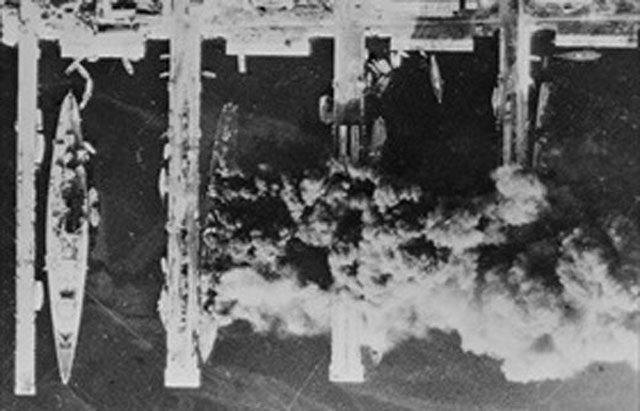 |
|
French Light Cruiser Marseillaise
|
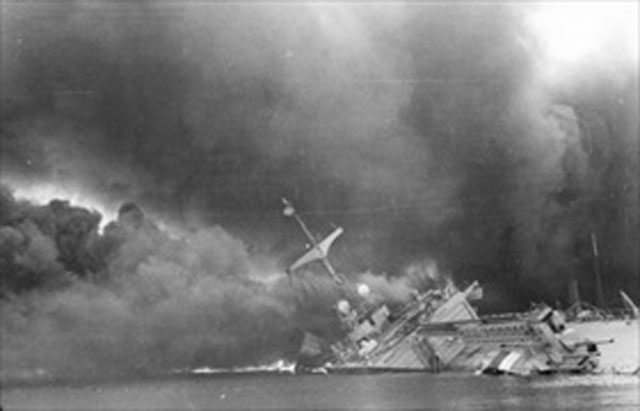 |
|
Australians Approach German Strong Point
|
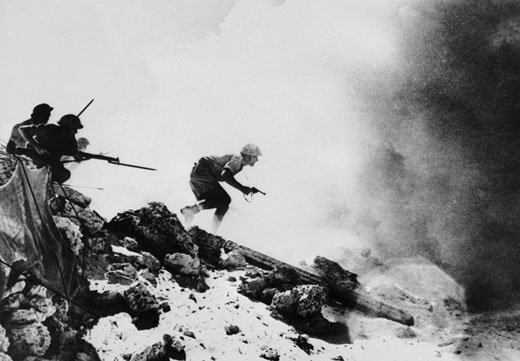 |
|
Saturday, November 28
Air Operations, CBI
THAILAND
- 9 7th Heavy Bomb Group B-24s attack an oil refinery at Bangkok, 2,760-mile round trip from their base in India.
[  | |   ] ]
Air Operations, Europe
BOMBER COMMAND
Evening Ops:
- 228 aircraft are sent to Turin: 117 Lancasters, 47 Stirlings, 45 Halifaxes and 19 Wellingtons.
- Part of the force bombs before the Pathfinders mark the target, but the rest of the force bomb accurately; some bombs drop near the Royal Arsenal; 67 people are killed and 83 are injured.
- 2 Stirlings and 1 Wellington are lost.
Minor Ops:
- 19 aircraft lay mines off the Biscay ports and there are 5 OTU sorties.
[  | |   ] ]
Air Operations, New Guinea 22nd Medium Bomb Group B-26s attack the airfields at Buna and Lae.
[  | |   ] ]
Air Operations, North Africa US bombers hit the port facilities and power stations at Tripoli.
[  | |   ] ]
Air Operations, Solomons AirSoPac B-17s attack a convoy off western New Georgia.
[  | |   ] ]
Air Operations, Tunisia - 37 XII Bomber Command B-17s of the 97th and 301st Heavy Bomb Group attack Bizerte Airdrome and port area.
- 2 bombers are lost to Luftwaffe fighters
- In their unit's first completed mission of the campaign, several 319th Medium Bomb Group B-26s attack the port facilities, oil tanks, and railway yard at Sfax. This is the first medium-bomber mission flown over North African soil by a 12th Air Force unit, and the first B-26 mission ever flown in the theater.
[  | |   ] ]
|
Battle of the Atlantic The US freighter Alaskan (5364t) is torpedoed, shelled and sunk by U-172 about 400 miles north of St Paul's Rocks with the loss of 6 of her crew and 1 Armed Guard sailor. The survivors enter lifeboats.
[  | |   ] ]
Eastern Front The tragedy of Stalingrad unfolds. Von Manstein, unknown to Hitler and in direct contradiction of the Führer's plans, works out Operation WINTER STORM, aimed at breaking the Russian encirclement and relieving the 6th Army. The Soviets announce they have launched an offensive on the central from and make considerable gains near Rzhev.
NORTHERN SECTOR
Heavy fighting erupts at the base of the Demyansk pocket as the Soviets strive to isolate the II Corps.
CENTRAL SECTOR
The VI Tank Corps drives forward again, smashing its way east but with crippling casualties. The Rzhev-Sychevka road is reached but the corps' lines are tenuous. Counterattacks by the 5th Panzer Division from the south and the 9th Panzer from the north almost cut the VI Tank Corps off from its supporting units. The Germans begin to contain the 39th and 22nd Armies, despite continued strong Soviet attacks. Increasing numbers of German reserves solidify the line.
Heavy fighting continues around Belyi as the 41st Army aims to envelop the town. Elements attempt to force their way east but encounter the 1st Panzer Division on its left and the 12th Panzer to its front.
SOUTHERN SECTOR
Manstein lays plans for the relief of the 6th Army. He intends to begin the operation as soon as possible to break the Soviet outer ring before it is strengthened. Operarion WINTERSTORM is scheduled to start in early December. Instead of taking the shortest route to 6th Army from the Chir at Nizhne Chirskaya, Group Hoth is to attack from Kotelnikovo where Soviet defenses are weaker. From Kotelnikovo the distance to the western tip of the Stalingrad pocket doubles and the relief force hs to cross two rivers (the Aksai and Myshkova), each easily fordable. To divert Soviet attention toward Nizhne Chirskaya, the XLVIII Panzer Corps is to pin down the 5th Tank Army and prevent its reinforcement of the Kotelnikovo axis. Hoth has at his disposal the LVII Panzer Corps, the remnants of the VI and VIII Rumanian Corps protecting either flank. The crux of the entire operation though is the ability of the 6th Army to push southwest to meet Hoth when he comes within striking distance. Hoth will link up with 6th Army and then pull back to the Don, abandoning the Volga so that 6th Army can be extricated.
[  | |   ] ]
French Somaliland A third of the garrison of Djibouti, until now loyal to the Vichy government, crosses into British Somaliland and adheres to the Allied cause.
[ ] ]
|
Indian Ocean Free French forces occupy the island of Reunion.
[  | |   ] ]
North Africa
TUNISIA
The 11th Brigade of the British 78th Division and the 2nd Battalion, 13th Armored Regiment, US 1st Armored Division, reach the outskirts of Djedeïda, 14 miles from Tunis. This is as close as the Allies get to Tunis before the final phase of the campaign. To the south the Germans evacuate Pont-du-Fahs, 35 miles southeast of Tunis. 2 British regiments are in danger of being surrounded south ot Djedeïda as the result of a brilliant turning movement by German armored troops from St Cyprien towards Tebourba. At Gafsa, the 3rd Battalion, 26th Regimental Combat Team, 1st Division, is attached to the 2nd Battalion, 509th Parachute Regiment.
[  | |   ] ]
Pacific Adm William F. Halsey, promoted from Vice-Admiral 2 days before, replaces Rear-Adm Kinkaid with Rear-Adm C. H. Wright in command of Task Force 67, which is responsible for patrolling Iron Bottom Sound between Savo and Guadalcanal to prevent the arrival of Japanese supplies. Task Force 67 comprises 5 cruisers, Minneapolis, Honolulu, Northampton, Pensacola and New Orleans, and 4 destroyers. The Japanese, who have lost their air and naval superiority in this sector, are trying to set up firm positions on the islands of New Georgia and Santa Isabel as jumping-off places for Guadalcanal.
[  | |   ] ]
United States, Home Front At least 493 people are killed in an accidental fire and subsequent panic at the Coconut Grove night club in Boston, Massachusetts.
[  | |   ] ]
|
Images from November 28, 1942
|
|
Americans Help An Australian
|
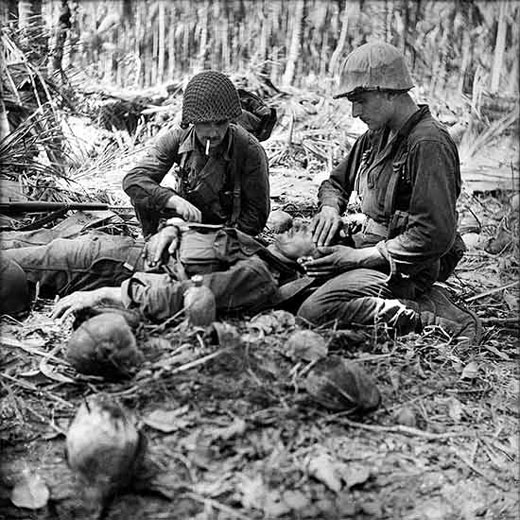 |
|
Coconut Grove Fire in Boston
|
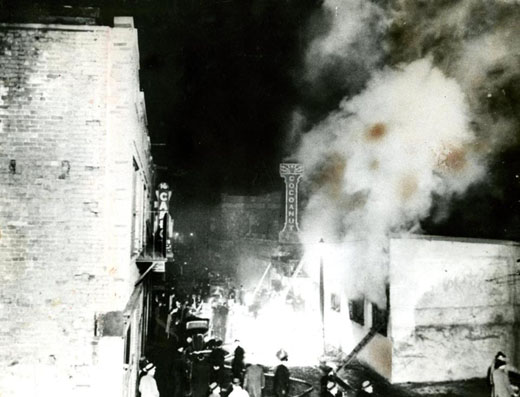 |
|
|
Sunday, November 29
Air Operations, CBI
FRENCH INDOCHINA
- 11th Medium Bomb Squadron B-25s attack coastal targets.
[  | |   ] ]
Air Operations, Europe
BOMBER COMMAND
Evening Ops:
- 29 Stirlings and 7 Lancasters of 3 Group and the Pathfinder Force are sent to Turin with the main target being the Fiat works.
- Weather conditions are poor and only 18 aircraft are known to have crossed the Alps and to have bombed Turin; reports from the ground indicate 16 people are killed and 15 injured.
Minor Ops:
- 6 Mosquitos are sent to Belgium to hit targets of opportunity in the first night operation for Mosquitos; railway yards at 5 locations in Belgium are bombed.
[  | |   ] ]
Air Operations, Libya IX Bomber Command B-24s attacking Tripoli harbor at dusk claim hits on 2 vessels, an anti-aircraft battery, docks, and warehouses.
[  | |   ] ]
Air Operations, New Guinea V Bomber Command B-17s and A-20s, and 49th Fighter Group P-40s attack numerous targets in the Gona area. B-25s and 1 A-20 attack the airfield at Lae. B-17s damage 2 of 4 Japanese destroyer-transports in the Vitiaz Strait, thus thwarting an effort to land Japanese Army ground reinforcements in the bitterly contested Gona area.
[  | |   ] ]
Air Operations, Tunisia - 44 C-47 transports of the 62nd and 64th Troop Carrier Groups drop 530 British Army paratroopers at Depienne, near Oudna Airdrome, 10 miles south of Tunis. The drop is highly accurate, but the ground attack fails ending in a months-long stalemate on the ground.
- 15th Light Bomb Squadron A-20s, escorted by P-38s, attack Gabes Airdrome.
- 1st and 4th Fighter Group P-38s down 2 Luftwaffe Bf-110 twin-engine fighters and 2 Ju-88 medium bombers during two separate actions.
[  | |   ] ]
|
Britain, Home Front Churchill broadcasts from London, warning the Italian people that they must choose between a full-scale Allied attack and a revolt against Mussolini.
[  | |   ] ]
Eastern Front The Russians continue to gain ground in the Stalingrad sector, and Manstein begins to see the danger into which his own army is falling. Fighting flares up again in the Caucasus, where the Russians begin a series of attacks in the Terek sector.
CENTRAL SECTOR
Heavy fighting continues around the Rzhev salient as Operation MARS grinds on. The 20th Army continues to throw forces into the offensive but suffers massive losses for almost no gain. The VI Tank Corps, isolated by German counterattacks, continues to push forward into destruction.
The 41st Army continues to attack Belyi in a vain effort to isolate the German garrison. Despite minor local gains, the Germans again prevent the fall of the town to the Soviets.
SOUTHERN SECTOR
The IV Cavalry Corps attacks Kotelnikovo, becoming embroiled in heavy fighting with the LVII Panzer Corps as it detrains. The 6th Army is also attacked on its southern perimeter as the Soviets attempt to push it away from the front on the Chir.
[  | |   ] ]
Guadalcanal The 3rd Battalion, 147th Infantry, elements of the 246th Field Artillery Battalion, part of the 9th Marine Defense Battalion, and additional Seabees are landed in the Koli Point area, where an airfield, Carne, is to be constructed. The Aola Bay area has been rejected as unsuitable for an airfield site. The Americans examine the possibility of withdrawing the Marines from Guadalcanal and giving operational responsibility to the army. More and more army units have reached the island in the last month or so. Gen Alexander M. Patch would succeed Gen Vandegrift, who has directed operations up to now.
The flagship Naganami, with the destroyer Takanami, and 6 supply destroyers set out with Adm Tanaka in command. The ships sail south during the night hoping to avoid American detection. A cruiser force under Read-Adm Carleton H. Wright is told to counter any and all night landing attempts by the Japanese. The cruisers have been divided into two groups making sure at least one ship in each is equipped with the newest search radar. 4 Destroyers of the task force will operate as one group under a division commander and are expected to make much more effective use of their torpedoes. There will be no searchlights for the Americans. If any are seen it is to be assumed it is a Japanese ship. 15 minutes after Tanaka has sailed, Wright receives a message from Halsey to be ready. The Japanese are sending a force to land troops and supplies at Guadalcanal and will arrive the night of the 30th. The US task force sails to make the 600-mile journey to Guadalcanal traveling at 28 knots.
[  | |   ] ]
|
Indian Ocean The US freighter Sawokla is sunk by torpedo and gunfire from the German auxiliary cruiser Michel about 400 miles southeast of Madagascar, while en route from Colombo, Ceylon to Cape Town, South Africa. 16 of the 41-man crew as well as 4 of the 14 Armed Guard are killed in the attack. Michel rescues 25 crewmen, 9 Armed Guard sailors and 5 passengers.
[  | |   ] ]
New Guinea Allied bombers intercept 4 Japanese destroyers in the Vitiaz Strait and attack, forcing them to change course. The 4 ships were transporting reinforcements from Rabaul, New Britain, to the Gona beachhead. Japanese troops who have withdrawn towards positions north of Gona along the west bank of the Kumusi River reach Giruwa on board a lighter.
[  | |   ] ]
North Africa
TUNISIA
The British 36th Brigade, advancing towards Bizerta, is held up by German paratroops on Djebel, Azzag, Green Hill, and Djebel Agred, Bald Hill.
The British 1st Army is stalled at Djedeïda by firm opposition, although the 11th Brigade, 78th Division, continues fighting there. A British parachute battalion of the British 1st Parachute Brigade lands at Depienne, 10 miles northeast of Pont-du-Fahs, with the task of capturing Oudna airport and threatening Tunis from the south, but they are repulsed and forced to retreat.
[  | |   ] ]
Pacific The German naval tanker Uckermark (ex-Altmark: see February 16, 1940) is sunk by an accidental explosion at Yokohoma. The blast also destroys the disguised raider Thor.
[  | |   ] ]
|
Monday, November 30
Air Operations, CBI
INDIAN OCEAN
- 7th Heavy Bomb Group B-24s attacking shipping in the Andaman Islands claim near misses that damage 1 vessel. This is the first in a series of attacks aimed at clearing the sea approaches to Burma.
[  | |   ] ]
Air Operations, Europe
BOMBER COMMAND
Evening Ops:
- 6 Wellingtons of 3 Group lay mines off La Pallice without a loss.
[  | |   ] ]
Air Operations, New Guinea In support of ongoing Allied ground attacks, V Bomber Command B-25s and 22d Medium Bomb Group B-26s attack Japanese Army defensive emplacements, anti-aircraft positions, and airfield facilities in the Buna area. 49th Fighter Group P-40s down 8 A6M Zeros over Buna at 1140 hours.
[  | |   ] ]
Air Operations, Tunisia - About noon, B-17s of the 97th Heavy Bomb Group, escorted by 16 1st Fighter Group P-38s, attack port facilities in Bizerte. 1 Bf-109 is downed and another damaged by a 27th Fighter Squadron pilot.
- 9 319th Medium Bomb Group B-26s, escorted by P-38s, attack Gabes Airdrome and the town's marshalling yard. The P-38s also strafe the airfield.
- 1 B-26 is downed over the target and another crash-lands in the desert due to battle damage
- 15th Light Bomb Squadron A-20s, escorted by P-38s, attack a bridge and the railway station at Djedeida.
- During the course of two of the day's three fighter actions, 14th Fighter Group P-38s down 2 Luftwaffe fighters, and a 52nd Fighter Group Spitfire downs another.
[  | |   ] ]
|
Battle of Tassafaronga The regular night run of the Tokyo Express again develops into a major battle. Tanaka in his 2nd Destroyer Flotilla has 8 destroyers and the US Adm Carleton H. Wright has 5 heavy cruisers and 7 destroyers. Although radar helps Wright get off the first shells and torpedoes the American fire is ineffective, with one Japanese destroyer, the Takanami sinking later. In the Japanese reply one cruiser, the Northampton, is hit by Japanese torpedoes and sinks the next day at 3:04am as a result of major leaks in the hull. 3 other cruisers, Pensacola, New Orleans and Minneapolis, suffer damage from Japanese torpedoes. Despite these successes Tanaka is reprimanded for failing to deliver his supplies to the starving Japanese forces on the island. Despite the failure of the supply convoy, the action again demonstrates Japanese excellence in naval night-fighting.[MORE]
Battle of Tassafaronga
|
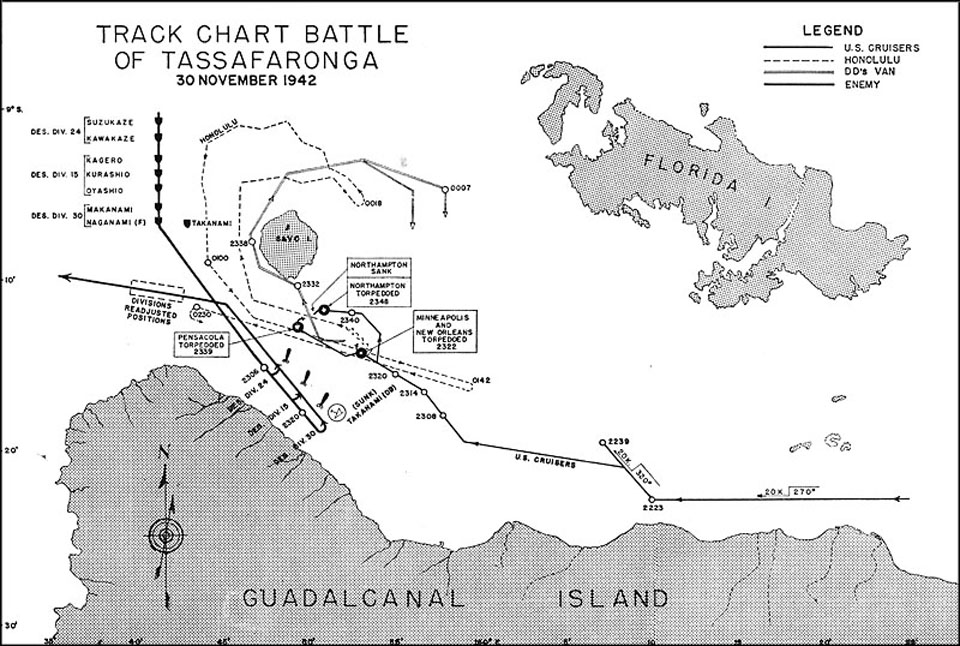 |
Burma The advance of the British 123rd Brigade in the Arakan has now reached Bawli Bazar. Terrible weather, which would normally be expected to clear during November, has been impeding the advance and making road
construction difficult.
[  | |   ] ]
|
Eastern Front
CENTRAL SECTOR
The Soviet VI Tank Corps is destroyed near Osuga. At Belyi, the 1st and 20th Panzer Divs force back the 41st Army.
SOUTHERN SECTOR
Group Hollidt (Gen Karl-Adolf) engages the Soviet 5th Tank Army on the Chir River.[MORE]
[  | |   ] ]
German Raiders The German raider Thor is destroyed by fire in Yokohama Harbor. In a cruise lasting from January to October 1942, Thor sank 10 ships of 56,000 tons.
[  | |   ] ]
New Guinea The Australian 21st Brigade, after a period of rest and reorganization following the campaign in the Owen Stanley mountains, replaces the 25th on the Gona front. In the Sanananda sector, turning the enemy positions, units of the 126th Regiment of the US 32nd Division block the Soputa-Sanananda track, but frontal attack on Sanananda itself are unsuccessful.
The Japanese 'Triangle' is still impregnable. Urbana and Warren Forces each make concerted attack but gain little ground. Urbana Force fails in 3 attempts to take Buna Village. Elements protecting the flank and rear seize a crossing over Siwori Creek and the outpost region between there and Buna Creek, but are unable to clear Coconut Gove or advance beyond the Triangle. Warren Force, attack toward Cape Endaiadere on the right and the northeast edge of New Strip on the left, encounters the enemy's main line of resistance in the Duropa Plantation but is unable to breach it. Bren carriers that were to have spearheaded the assault in this sector failed to arrive.
[  | |   ] ]
North Africa
TUNISIA
The Germans and Italians have managed to land in Tunisia up to this date about 15,500 combat troops, who without too much effort are containing the offensive thrusts of the British 1st Army and the American and French divisions. The 11th Brigade of the British 78th Division fights off German attacks near Djedeïda. The British 1st Army prepares to launch an attack on Tunis by Blade Force and Combat Command B, US 1st Armored Division, on December 2. Combat Command B is concentrated in the Medjez el Bab area and Blade Force in the vicinity of Chouïgui.
[  | |   ] ]
|
Images from November 30, 1942
|
|
US Navy Ships Head for Guadalcanal
|
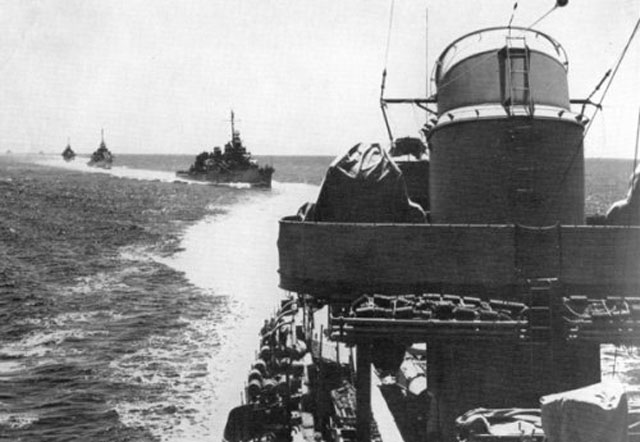 |
|
|
|
